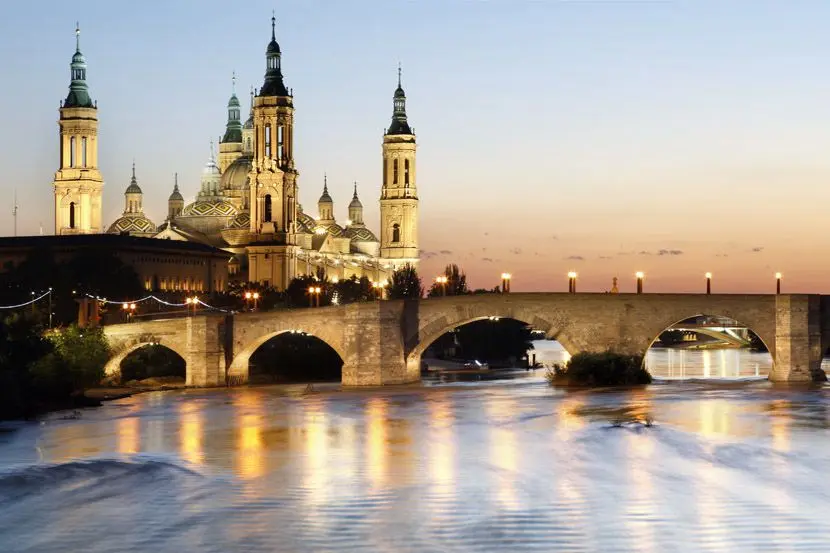
Click here to increase size
Welcome to Zaragoza! With this new and free audio guide (audioguides) service, you will get to know the city in an easy and comfortable way. It is divided into eleven independent tracks where you will discover the most significant areas and monuments of the city, as well as its history, gastronomy, and leisure and entertainment options. We invite you to fully enjoy Zaragoza.
ALJAFERÍA. MUDEJAR WORLD HERITAGE SITE
We are before La Aljafería, the most important Islamic civil construction of the XI century which was erected as a leisure palace by the Muslim monarchs of Zaragoza. It was also the headquarters of the first order cultural court, where King Al-Muqtadir surrounded himself with scientists and intellectuals, turning it into one of the most exciting periods in the city's history.
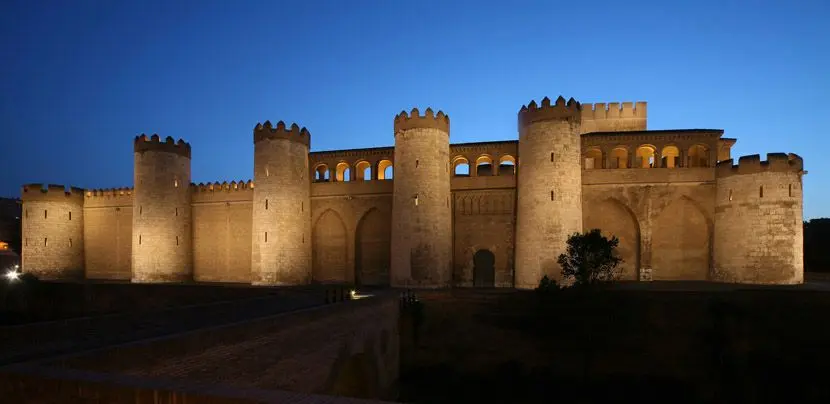
We can still recall the splendour of the taifal palace when entering the Patio of Santa Isabel, strolling past the orange trees, under the arcades, looking out the oratory and contemplating its entirety from the Golden Room. It is worth stopping with the audioguide (audioguides) at the oratory or mihrab, which faces the Mecca and is of small dimensions due to its private use.
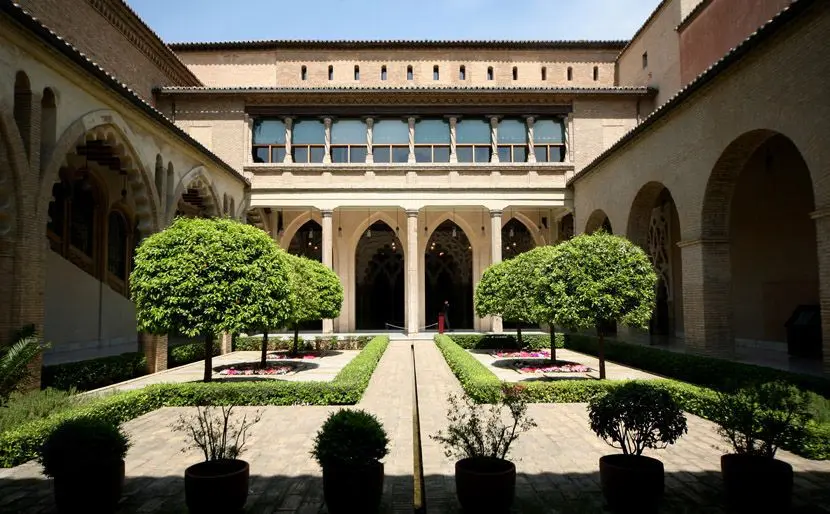
In this area, the mixtilinear and multi-foliated arches of indisputable quality are also worth mentioning, making La Aljafería one of the most beautiful examples of Hispanic Muslim art.
In the medieval age, it became the residence of the Aragon monarchs, who turned the palace into the stage of royal crowning ceremonies. In the XIV century, King Peter IV the Ceremonious ordered the construction of new Mudejar style rooms.
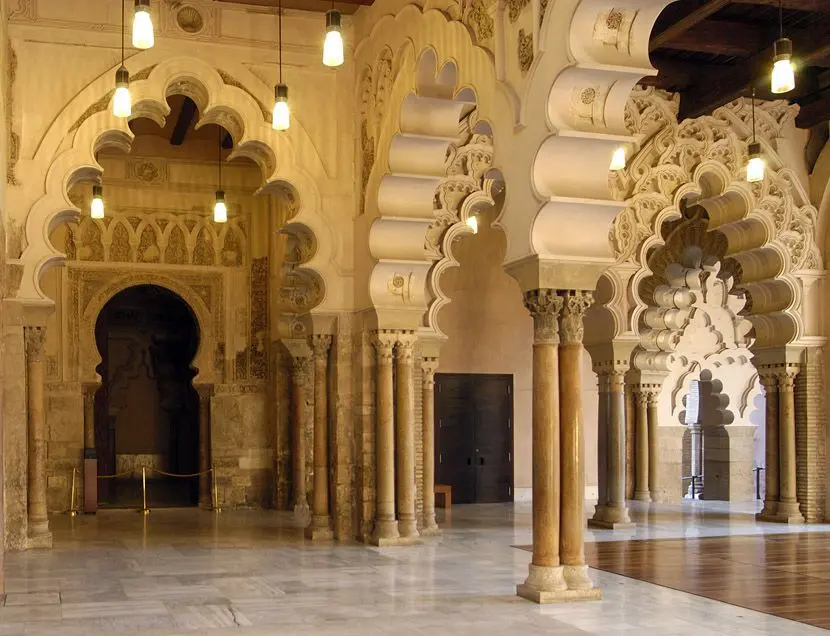
Let's go up with the audioguide (audioguides) to the floor which belonged to the Catholic Monarchs, who also participated in the building during their reign, at the end of the XV century, by creating spaces such as the striking Throne Hall, with its magnificent carved coffered sealing from which large golden pine cones hang. This artistic style, a mix of Mudejar, final gothic and first Renaissance, can be seen in The Lost Steps and the large entrance staircase providing access to the gallery.
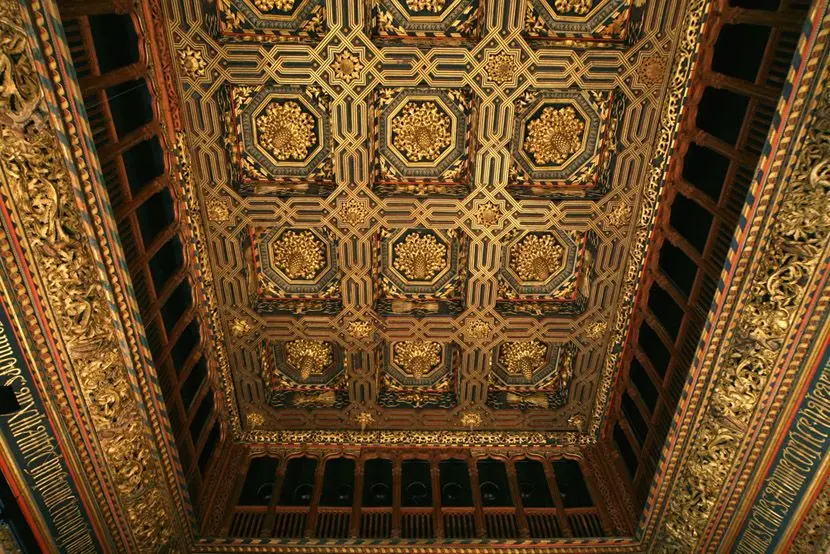
Phillip II ordered the transformation of the palace into a military fortress at the end of the XVI century. The building continued with this military function until the 60s of last century. In 1987, it became the headquarters of the Aragonese Courts and the current appearance of the building is the result of a long and careful restoration which ended in 1998.
CHURCH OF SAINT PAUL
We leave La Aljafería and head towards the Neighbourhood of San Pablo with the audioguide (audioguides), where we find the church of the same name, the first Mudejar temple in Zaragoza built in the XIII century. Its octagonal tower and Almohad minaret structure stand out in its exterior. In fact, it is composed of two towers, one within the other, featuring a staircase in between.
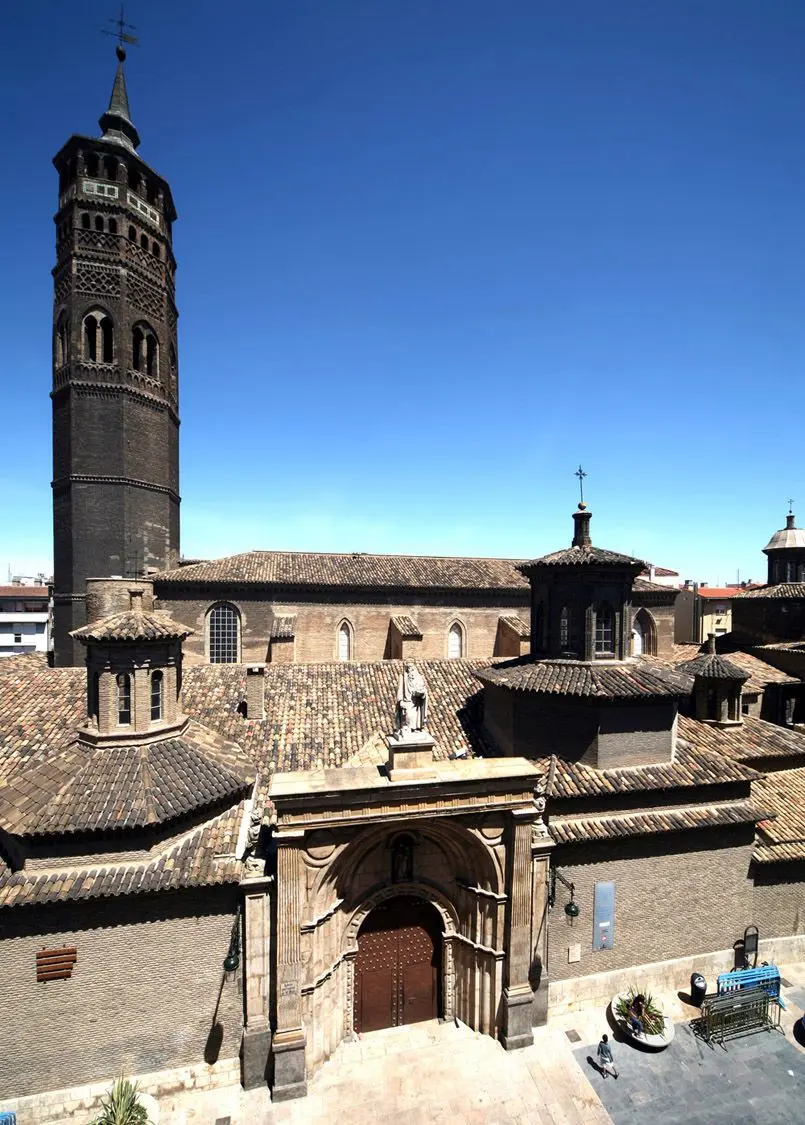
The interior currently presents three naves, a result of its extension during the XV century. Originally, it was composed of only one nave with a polygonal apse, chapels in between buttresses and a groined vaulting roof. The magnificent main altarpiece, of golden and polychrome wood, is a work by Damián Forment, the same artist who produced the main altarpiece of Pilar.
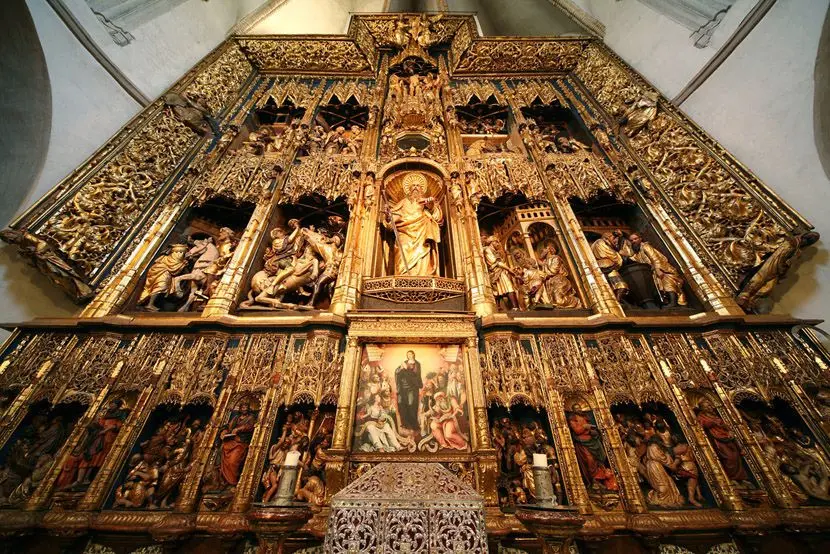
Although it hasn't been mentioned in the audioguide (audioguides), it is worth pointing out that Mudejar art is the most established artistic style in Aragon, a fusion between Christian and Muslim traditions and techniques. In December of 2001, the UNESCO declared the Aragonese Mudejar a World Heritage, due to its singularity and for being an artistic style born from the coexistence of Muslims and Christians for centuries in our territories. In Zaragoza, three buildings stand out: La Aljafería palace, Saint Paul's Church and La Seo.
THE WATER PARK AND THE EXPO ENCLOSURE
In order to enjoy nature in the city, there is no better option than visiting the Luis Buñuel Metropolitan Water Park with the audioguide (audioguides). It was inaugurated in June 2008 and it stretches through the Ranillas Meander, next to the International Exposition enclosure. In this park, besides being a green space with characteristic riverside vegetation, we can find other attractions such as theatre for children and adults, a fluvial beach, botanic gardens, calm water canals for practicing canoeing, wildwater canals for practicing rafting, a multi-adventure area, a hand-made hydraulic noria, as well as restaurants and many more options.

In addition, the park is located next to the Expo enclosure's river front, a new linear park along Ebro's riverbank which stretches from the Bridge Pavilion to the Voluntariado Footpath. From this location we can view some emblematic buildings and works built on the occasion of the Expo, such as the Water Tower, the Bridge Pavilion, the Third Millennium Bridge, the Spain Pavilion or the Fluvial Aquarium. It is worth mentioning in this audioguide (audioguides) a bit about each one of them, as they are symbols of the new city.
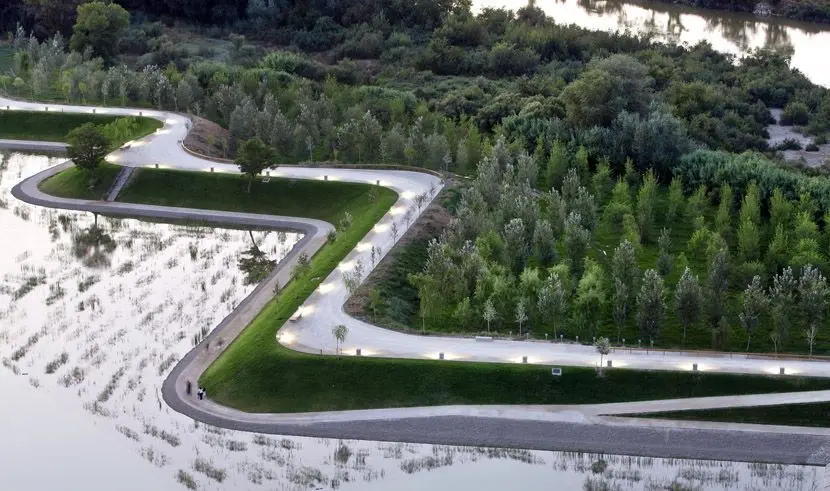
The Water Tower was named like this due to its ground plan inspired in a drop of water, which makes the building adopt different shapes depending on the view point. In a near future, it will be transformed into a temporary exhibition centre of contemporary art, managed by the Caja de Ahorros de la Inmaculada.
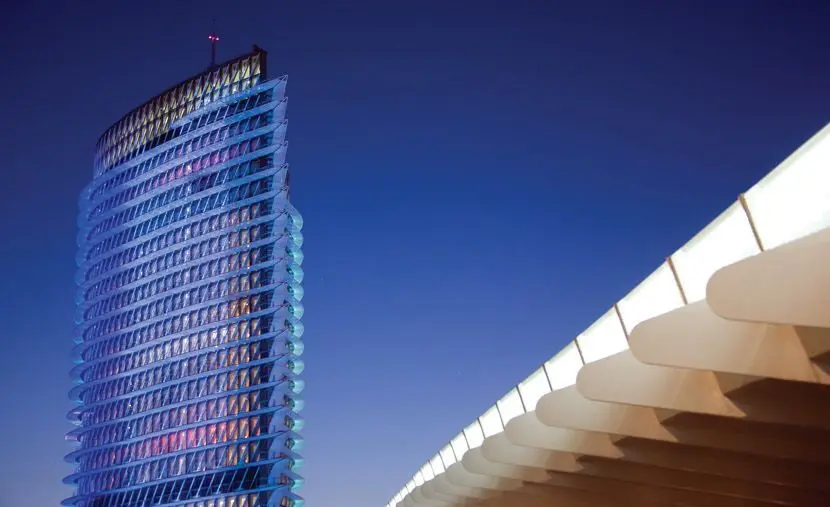
Practically at the feet of the Tower we can see the Conference Centre of Aragon, with a very singular jagged outline.
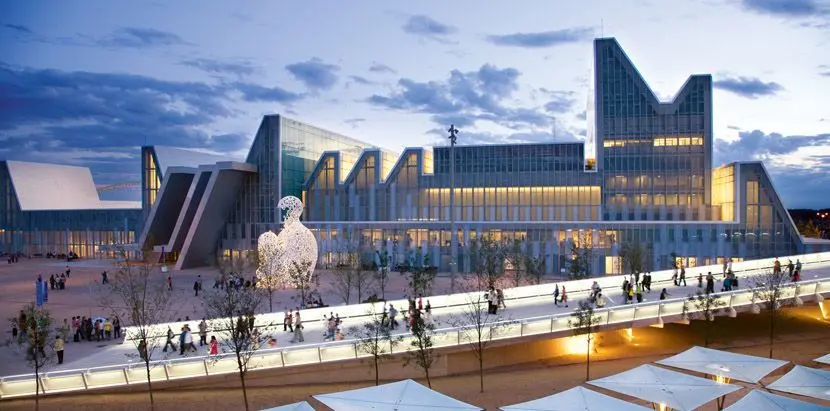
Another iconic building that the audioguide (audioguides) shows us is the Bridge Pavilion, designed by the prestigious Iraqi architect Zaha Hadid. Its ground plan simulates a gladiolus with one end supported by the right riverbank and the other branching out in three stems and supported by the left riverbed, where we are right now. IberCaja will manage this building and transform it into a museum, most certainly related with new technologies.
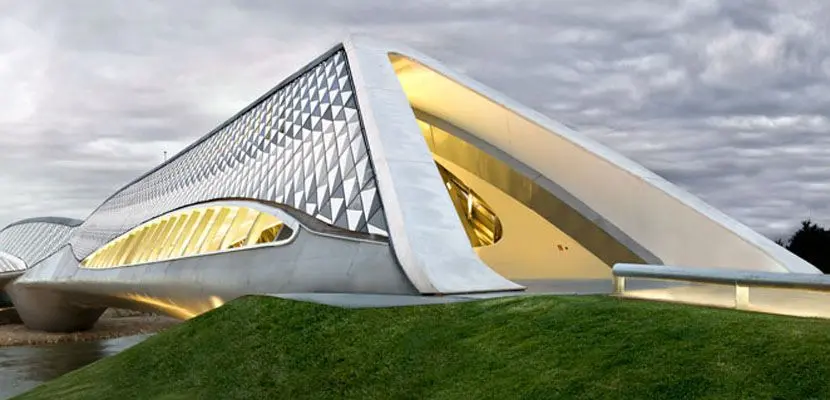
Next, we can see with the audioguide (audioguides) the Third Millennium Bridge, a work by engineer Juan José Arenas from Huesca. Together with the Bridge Pavilion, this work can be found in lists of the best and most beautiful bridges in the world.
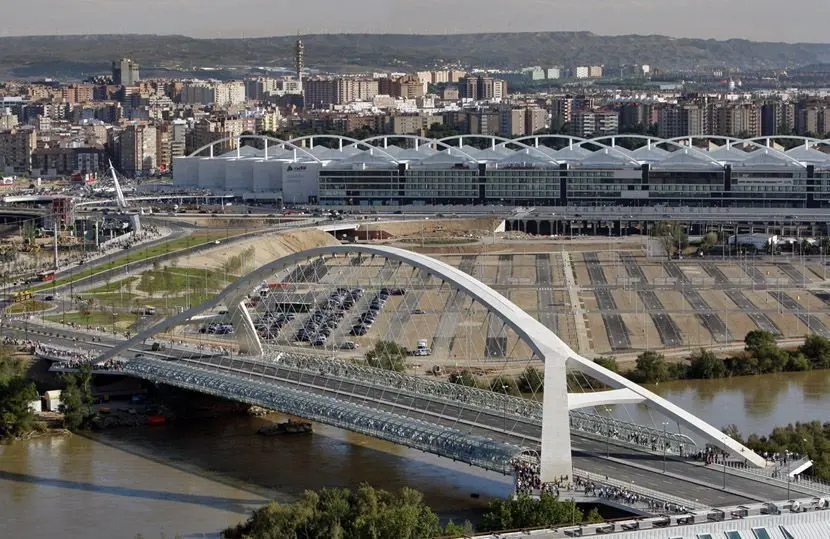
The Spanish Pavilion we can see with the audioguide (audioguides) is easily recognisable due to the forest of clay columns surrounding it, contributing to a micro-climate which cools down the temperature in the summer, making it a sustainable building. We mustn't forget that the Expo slogan was "Sustainable development and water". Since its inauguration, the pavilion has been awarded several national and international prizes.
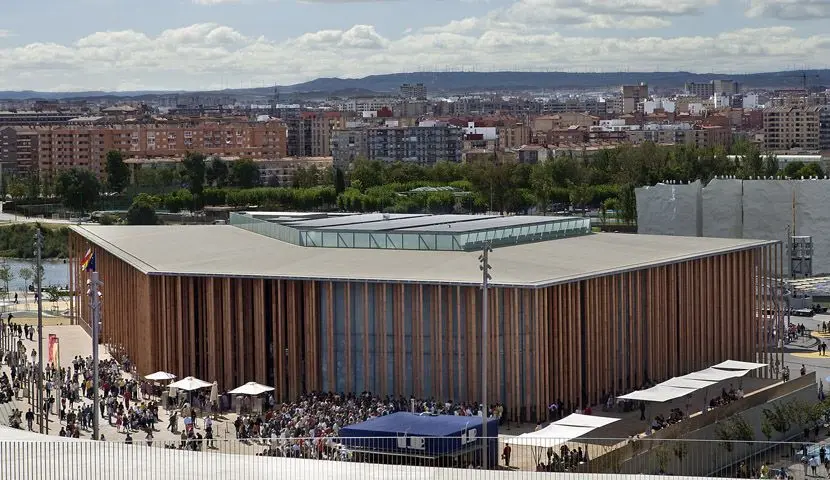
And, lastly, the Fluvial Aquarium, the largest fresh water aquarium in Europe. Its exhibition is centred on a route along five large rivers: Africa's Nile, America's Amazon River, China's Mekong, Australia's Darling and Spain's Ebro. In the centre of the aquarium we can see the World's River, a large tank simulating the origin of the World.
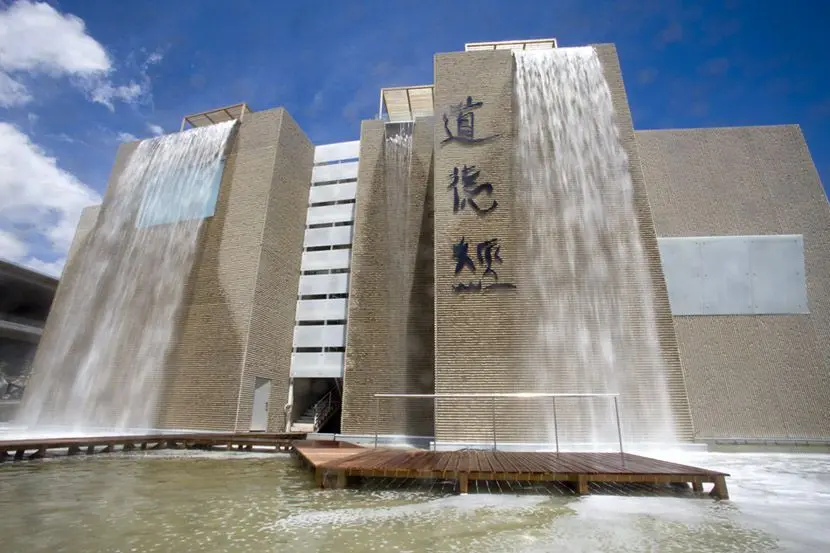
And now we are left to just enjoy this marvellous setting...
PILAR SQUARE AND SURROUNDINGS
We are now with the audioguide (audioguides) at the famous Pilar Square, an enclave where the city originated, a centre of Marian pilgrimage and a meeting point for people from Zaragoza and its visitors. In addition, this square features some of the most important buildings in the city, composing its history throughout the centuries. And its in the year 14 B.C. that the roman city Caesaraugusta was founded in these surroundings, where we can still enjoy the remains of walls, the forum, the fluvial port, the thermae or the theatre.
But the square's history doesn't end here, as virtually all the historic periods Zaragoza has been through are represented by the immensely beautiful buildings. Probably the most breathtaking is the San Salvador Cathedral, known as La Seo, which is erected on the East side and is in itself a journey through the city's history. But let's save it for later, as it is worth dedicating an entire section to this striking treasure.
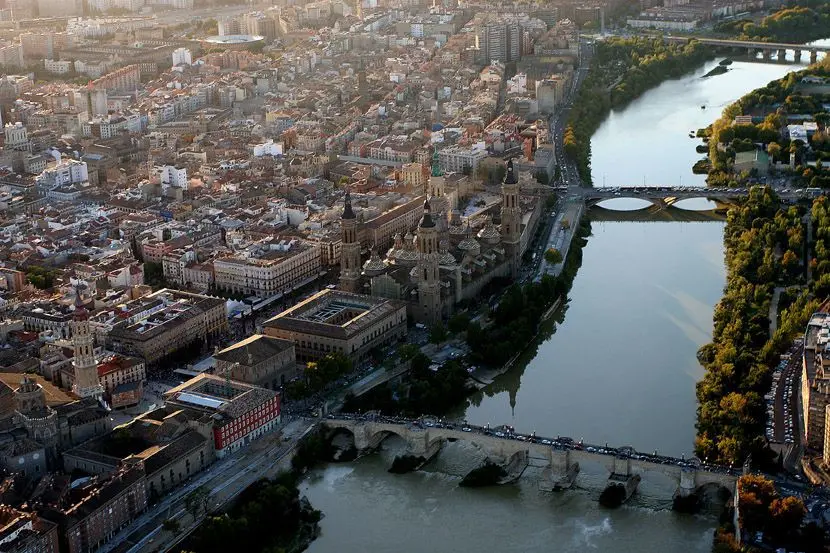
Next to Don Jaime I street, we can see with the audioguide (audioguides) the Market Exchange, one of the most important Spanish Renaissance civil buildings. Up to its construction in the XVI century, trade and business were made by merchants at La Seo and other churches. As common practice in that period, the Market was built in brick following an architectural layout similar to those of palaces: a large access door, a main floor with picture windows, a gallery of arches, and a large overhanging eave carved in wood. Polychrome plaster portraits of several important personalities of the period stand out. The clear and very spacious interior is due to the commercial characteristic of the building and has allowed its use as a temporary exhibition hall for the Town Hall.
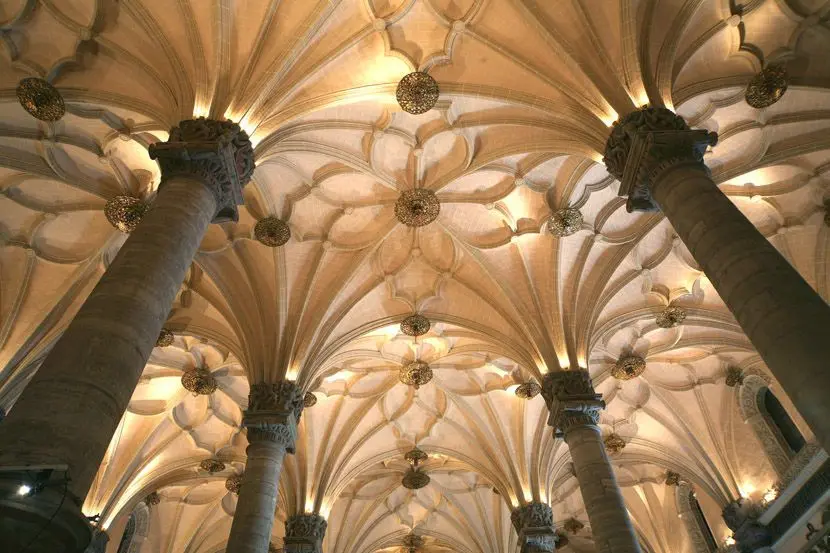
Behind the Market Exchange we find the Stone Bridge, which works were initiated at the beginning of the XV century.
On the other side of River Ebro, at the feet of the bridge we can cross with the audioguide (audioguides), we can see the recently inaugurated Balcony of Saint Lazarus. It is a new interpretation centre which features archaeological remains from the Cathedral of Saint Lazarus as well as an extensive pedestrian viewpoint. The convent was inaugurated in 1224 and featured 3 cloisters, although currently only Claustro del Pozo remains, a place where local people used to collect water. During the Sieges of Zaragoza in 1808 and 1809 it was fortified by means of batteries so as to defend the city and allow the provision of supplies, even general Palafox used it as barracks, actions which caused almost the entire building to be destroyed. Following the Confiscations of Mendizábal, in 1836, the Army occupied some of the spaces and in the 40s of the XX century, Saint Lazarus Barracks was erected on the remains of the convent. In 1983 it was demolished and a parking area for buses and a small green space was built on this plot of land. From this viewpoint, there is a beautiful panoramic view.
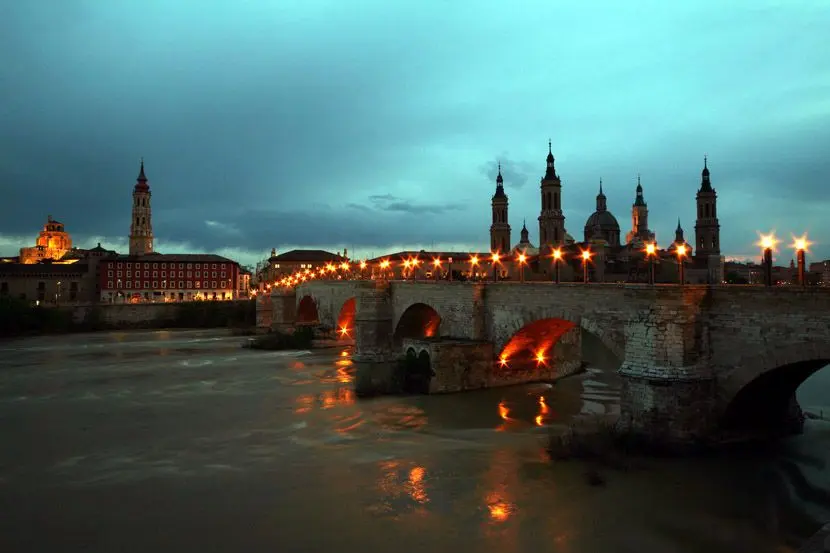
We cross the Stone Bridge again with the audioguide (audioguides) and reach Pilar Square, where we find the largest sculpture monument dedicated to Francisco de Goya, and you couldn't ask for more, as it is our most universal painter. The statue of this genius from Zaragoza is placed on a pedestal, dominating the two couples of majos and majas which seem to be taken from one of his paintings. The site is completed with the painter's own cenotaph, a small and simple cylindrical monument featuring a gravestone allusive to Goya and his niece's family, the Goicoechea. It is a gift from the city of Bordeaux, due to this place being where the painter died in 1828.
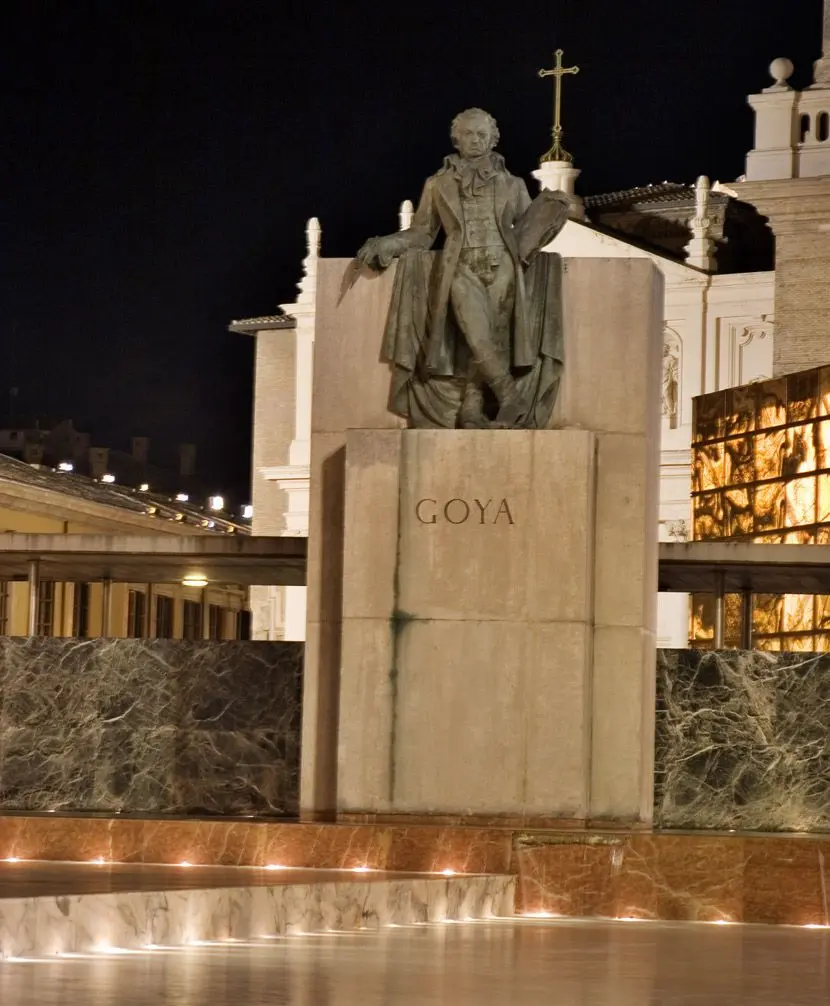
Next to the Market Exchange we can see with the audioguide (audioguides) the Town Hall, a building from the second half of the XX century, but which follows the design and materials used in the Market Exchange. On both sides of the main door, there are two monumental sculptures by Pablo Serrano welcoming visitors. They are San Valero, patron saint of the city, and the city's Guardian Angel.
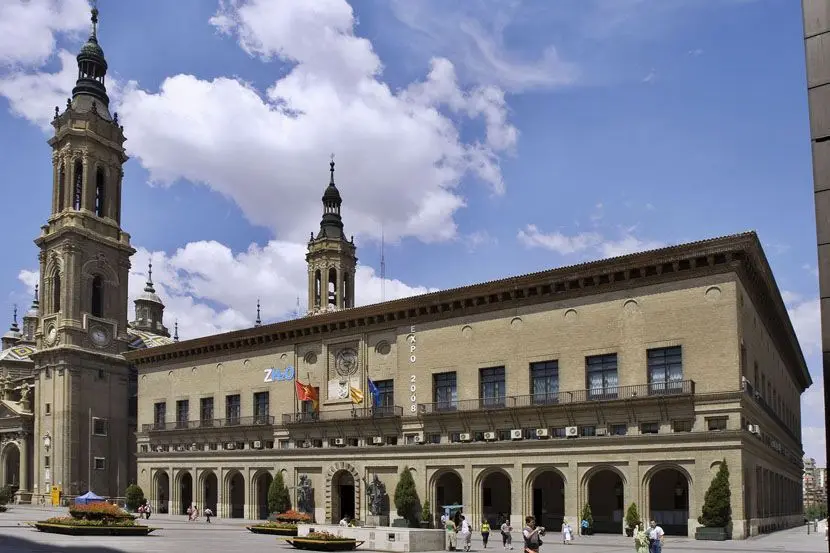
At the far end, on the East side of the square, we can see the Fountain in honour of Hispanic Heritage, a theme which was chosen due to the fact that the Pilar Virgin is the patron saint of Hispanic-heritage. It is composed of a ramp from which water falls and a tank shaped in a map of Central and South America. Three marble blocks evoke the three Columbus caravels and the site is completed by a globe. If you would like to see it from a better perspective, we recommend you go up the Pilar Tower with the audioguide (audioguides), you will certainly enjoy it.
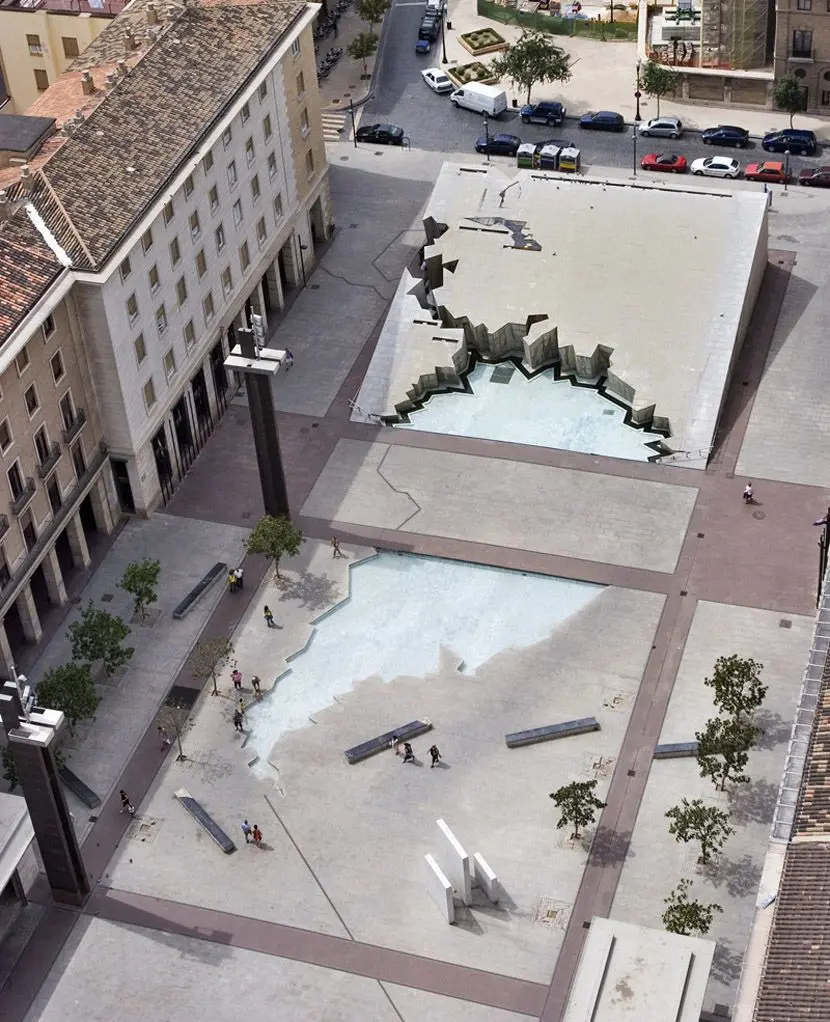
In the small square, behind this fountain, we can see the Church of San Juan de los Panetes, with its characteristic tilted tower, the Zuda Tower, currently a municipal tourism office and panoramic viewpoint, and the best preserved remains from Caesaragusta's Roman wall. We can also find with the audioguide (audioguides) the Central Market very close from here, featuring all the typical products part of Zaragoza's gastronomy.
BASÍLICA OF PILAR
The audioguide (audioguides) will allow you to discover one of the most important Marian sanctuaries in the Catholic world, to which millions of pilgrims arrive yearly, and the reason why Zaragoza is known practically all around the world.
But before entering, I am going to tell you a bit of the interesting story behind this building, as legend says that on the night of the 2nd of January of the year 40 AC, Virgin Mary arrived to Zaragoza in flesh and blood to encourage Apostle James, who was preaching the Gospel at the riverbank of River Ebro. As a symbol of this fortress she brought a column which currently holds the gothic sculpture of the Pilar Virgin.
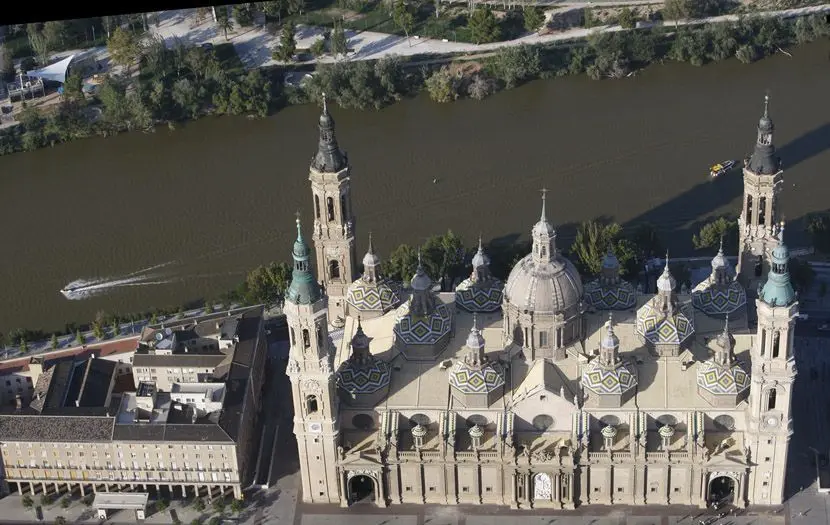
The building we see nowadays with the audioguide (audioguides) corresponds to the XVII and XVIII centuries, which is when it was decided to build a larger temple in order to satisfy the growing devotion. The general design was supervised by the royal architect Herrera el Mozo and in 1750 the renovation of the interior decoration was entrusted to Ventura Rodríguez, also an architect for the King. His most impressive work is the Saint Chapel, planned as a temple within the temple. The sculpture representation of the Arrival of the Virgin is conceived with a great sense of theatre: Mary directs her look towards Apostle James and points towards the Pilar which remains testimony of her presence. The column is covered with a shroud which is changed daily. The shroud is removed from the column only on the 2nd, 12th and 20th of each month. On the Pilar we can see an image of the Virgin with the child, a gothic sculpture of the XV century which is hardly thirty six centimetres high. Its small size does not correspond to the great devotion it evokes within the catholic world.
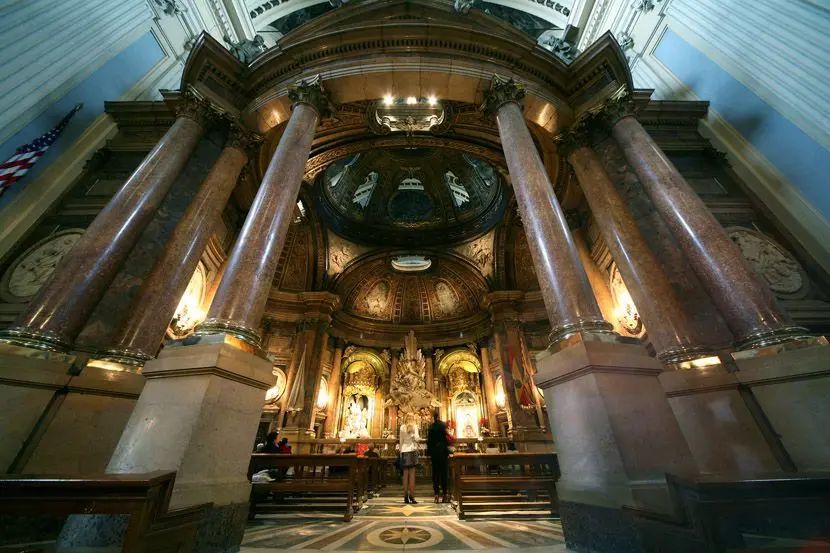
In front of the Saint Chapel we see with the audioguide (audioguides) the Coreto, where Goya painted the fresco “The Adoration of the Name of the Lord” in 1772, his first significant work after arriving from Italy. It represents a group of musician angels singing and glorifying the Lord's name, written in Hebrew inside a central triangle.
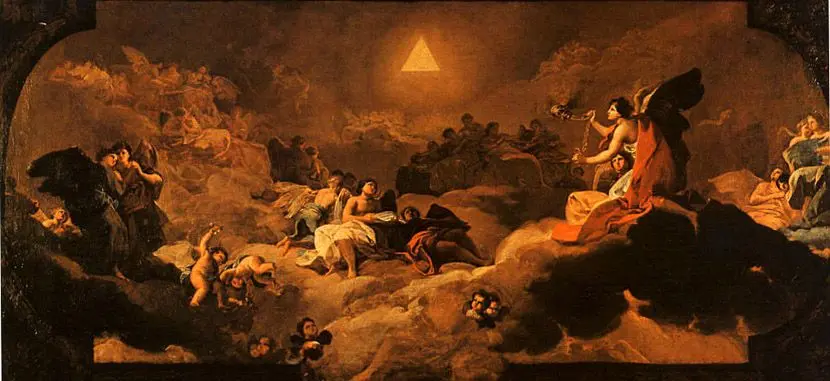
In this area, two bombs hanging on the right of the Saint Chapel stand out. During the Spanish Civil War an aeroplane dropped 2 bombs over the basilica and didn't detonate. They fell through the ceiling causing two holes which are still preserved. Can you find them? One is underneath the golden frame of Goya's Coreto painting and the other is in one of the medallions, between that vault and the Saint Chapel.
The flags which are displayed in this area belong to Spain and Latin America as the Pilar Virgin is patron saint of Hispanic-heritage.
With the audioguide (audioguides), we are heading towards the “Regina Martirum” dome, painted by Goya in 1780. It represents Mary as the Queen of Martyrs and we can immediately appreciate that it is a totally different work from the aforementioned, as it uses very bright colours, applied with large brush strokes and patches of colour, granting great expression, naturalism and plasticity to the characters. What we now see as a prelude to impressionism, in that era provoked significant tensions with the chapter and his brother and boss Francisco Bayeu, who accused him of producing a hurried and sloppy painting. Nowadays, without any doubt, we can say it is one of the masterpieces by this Aragon genius.
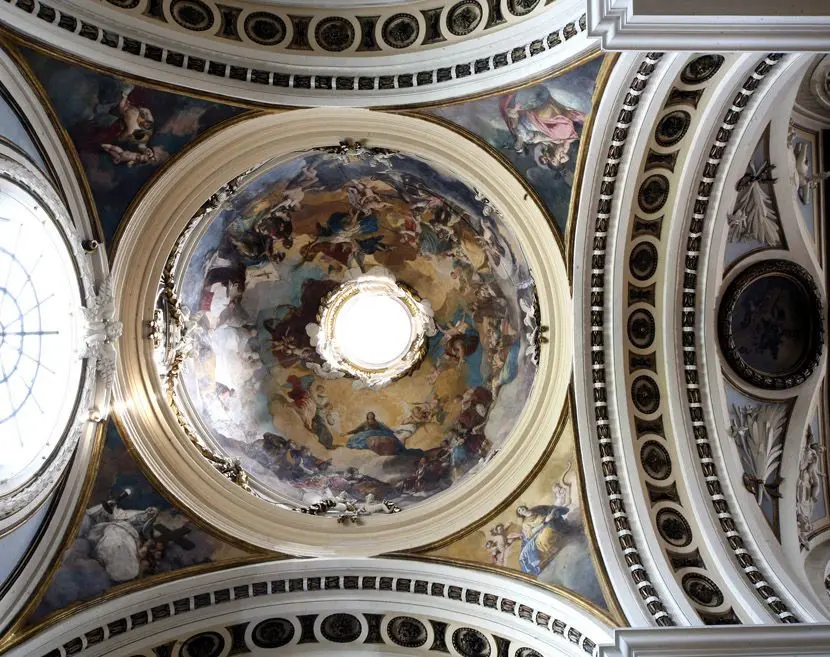
Another gem is the Great Altar's Altarpiece made by Damián Forment in the XVI century. It is worth mentioning in this audioguide (audioguides) that the contract scriptures for this work specified it should be equal or better than La Seo. It is made in alabaster and is divided in two bodies: the bottom has seven scenes which are dedicated to the life of the Virgin and her son, and the top, in form of a triptych, features scenes of the Temple Introduction, Assumption of Mary and the Birth of the Virgin.
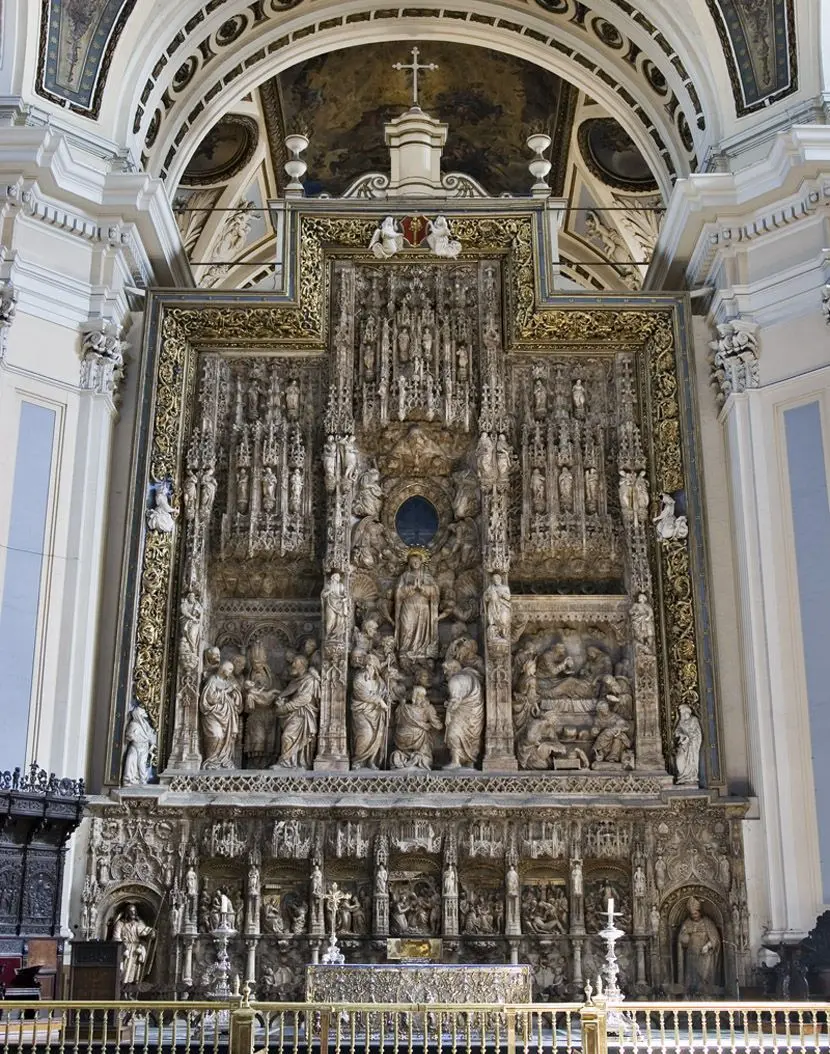
Ending our audio-guided visit, we reach the Great Choir, located in front of the altarpiece, at the feet of the central nave. It is composed by iron work and ashlar, made in the mid XVI century with oak from Flanders and yellow boxwood. The high backs are carved with scenes of the Old and New Testament. The organ is an interesting combination, featuring a case from the XVI century with a musical instrument from the XXI century, which was used for the first time at the beginning of 2009.
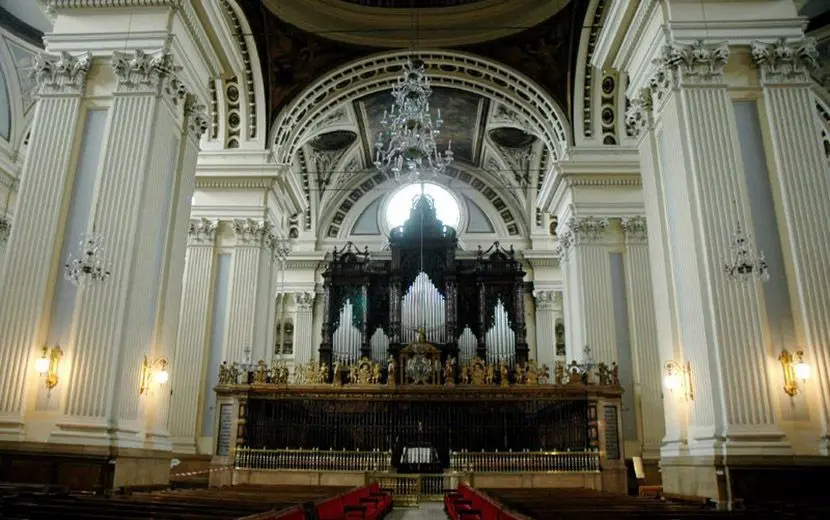
LA SEO AND SURROUNDINGS
Let's visit with the audioguide (audioguides) La Seo del Salvador, the oldest cathedral in Zaragoza. It is erected on the same plot of land where the Roman temple Forum of Caesaraugusta, the Visigoth church and the great Muslim mosque were located. In the mid XII century, following the Christian conquest of the city, the old mosque was demolished in order to commence the construction of a Romanesque church. Throughout time the temple was extended, following artistic trends belonging to each period. As a result, La Seo gathers all the artistic styles developed from the XII to the XVIII centuries, from Romanesque to Neoclassicism.
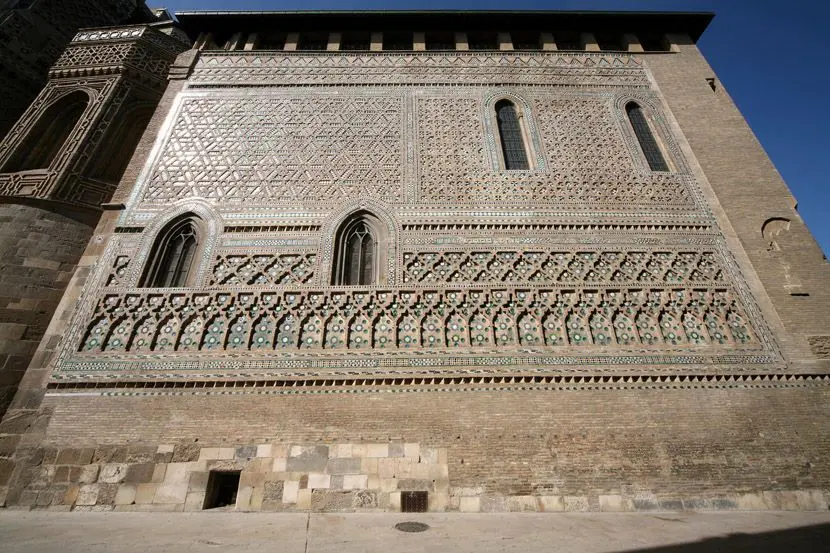
In the exterior, facing Saint Bruno Square, it is worth mentioning in this audioguide (audioguides) the two apses which have been preserved from the Romanesque church. Next to said apses a beautiful Mudejar wall made of brickwork and tiles, called the wall of the Parroquieta and which closes the funeral chapel of archbishop Lope Fernández de Luna catches our attention. The outside image of the cathedral is rounded off by a slender Baroque tower and a Neoclassical main facade.
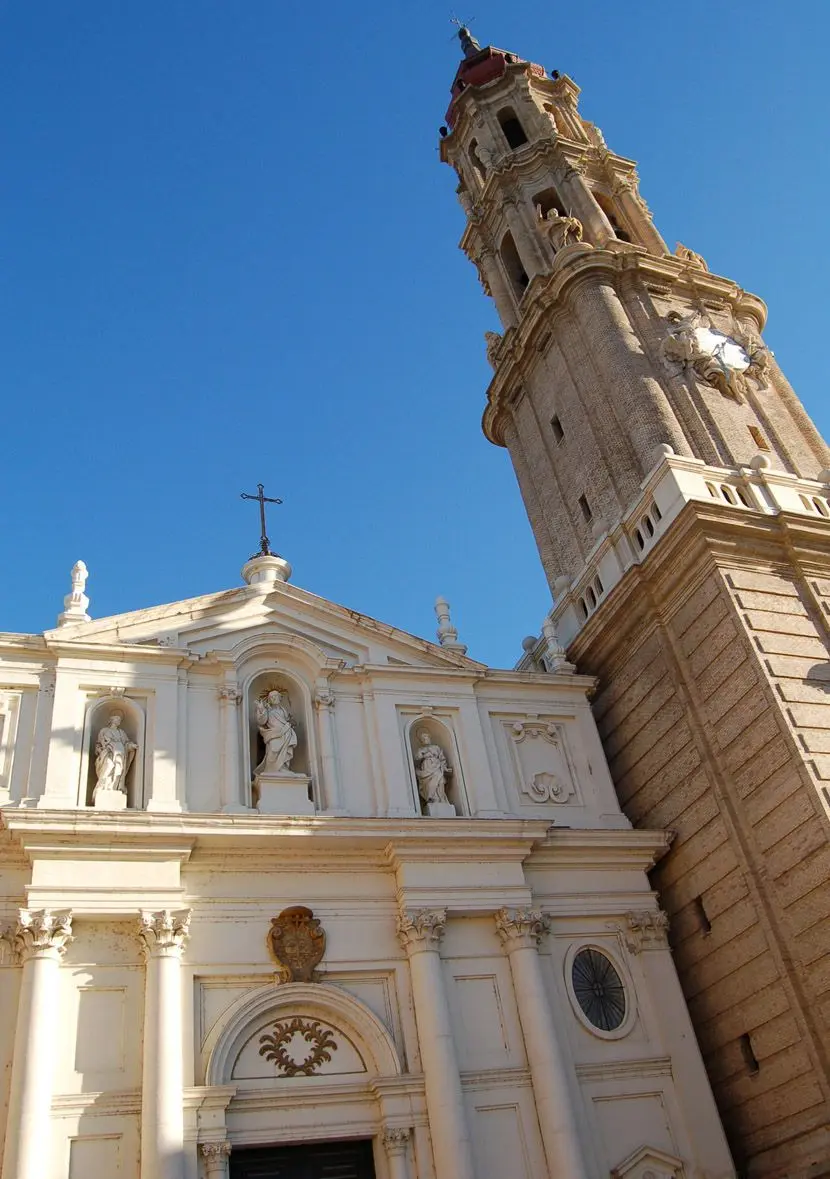
In the interior, we find with the audioguide (audioguides) a Floor plan divided into five naves covered by magnificent star-ribbed vaults. A long restoration process which started in 1980 has returned all the building's splendour. This space, formerly blackened and dark, is currently flooded by natural light which entering through the windows, the chapel's lanterns and the dome base.
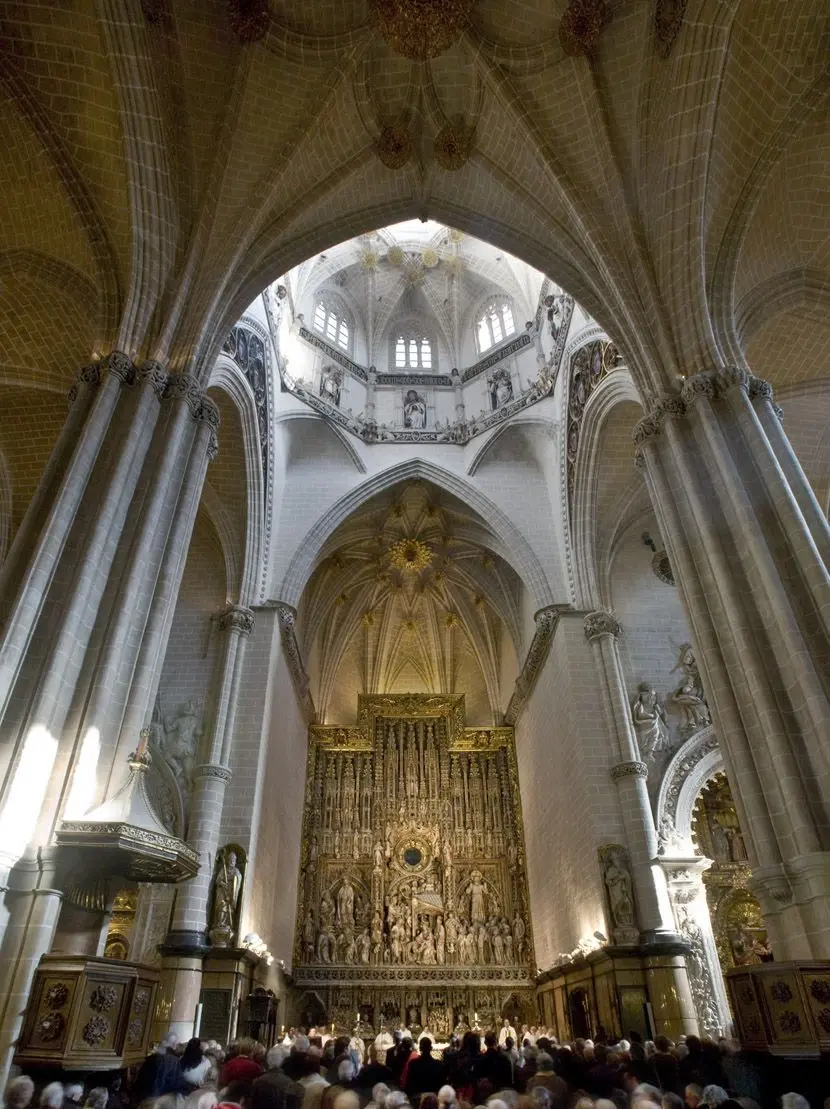
By getting closer to the great altar with the audioguide (audioguides) we find one of the best gothic altarpieces in Europe. It is made of polychrome alabaster and its three main scenes represent the three Christ Epiphanies: the Transfiguration, the Adoration of the Magi and the Ascension. In addition, the great altar of La Seo was the stage for the crowning of Aragon Monarchs.
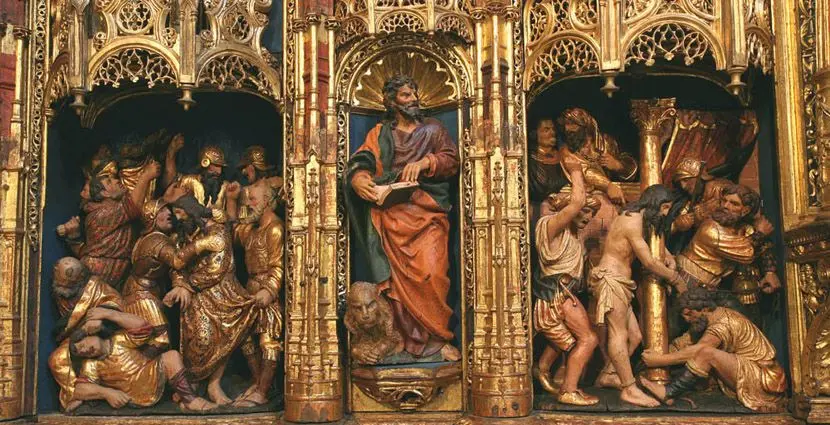
The Great Choir features gothic ashlar in oak and it is worth mentioning that the organ's case dates back to the XVI century. Much more interesting is the Retrochoir, made in gypsum with reliefs which mainly represent saints from Aragon.
Between the chapels of the cathedral, two of the best religious Renaissance sites from Aragon stand out: the Chapel of Saint Bernard (at the church's feet), the funeral chapel of archbishop Don Hernando de Aragon, and the Chapel of the Archangel Saints, the pantheon of the Zaporta family (in the left nave). It is also worth mentioning in the audioguide (audioguides) the Chapel of the Santo Cristo (behind the Retrochoir), which includes one of the greatest devoted images among the local people.
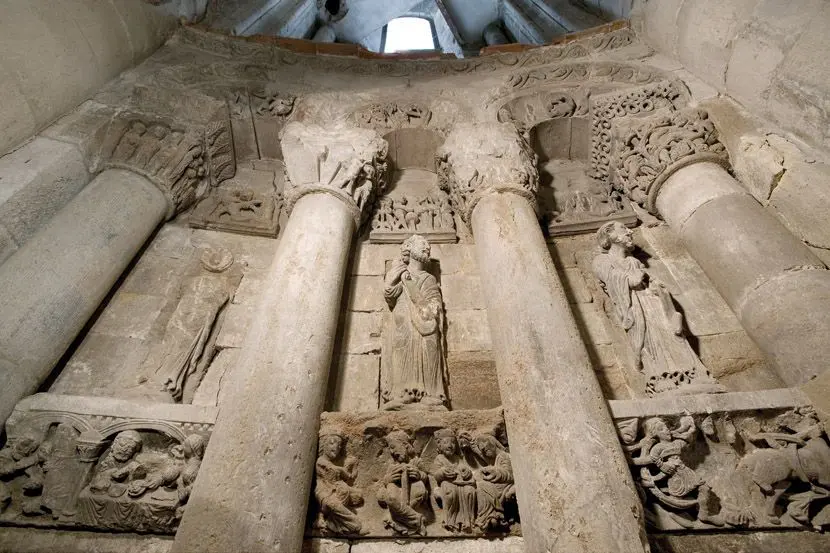
In the La Seo Chapterhouse Tapestry Museum we find one of the best tapestry collections in the world. The collection is composed of 63 cloths covering biblical, historical, mythological and moral themes. Most of the pieces date back to the XV, XVI and XVII centuries, the golden age of tapestry art, and come from the main production centres of the period: workshops in Arras, Tournai and Brussels.
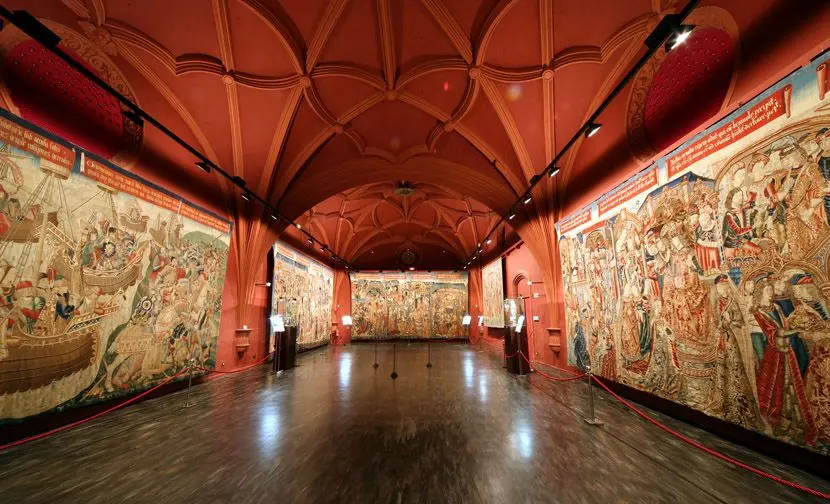
Exiting through the Saint Bruno door, on the right, we can see with the audioguide (audioguides) the Arch of the Dean. Its origin goes back to the XIII century, when the Dean of the Cathedral required permission to build a path linking his house with the temple. The Mudejar style gallery dates back to the refurbishment that took place in the XVI century; and, at the back, we can see the decoration resembling a brick wall, so characteristic of this style.
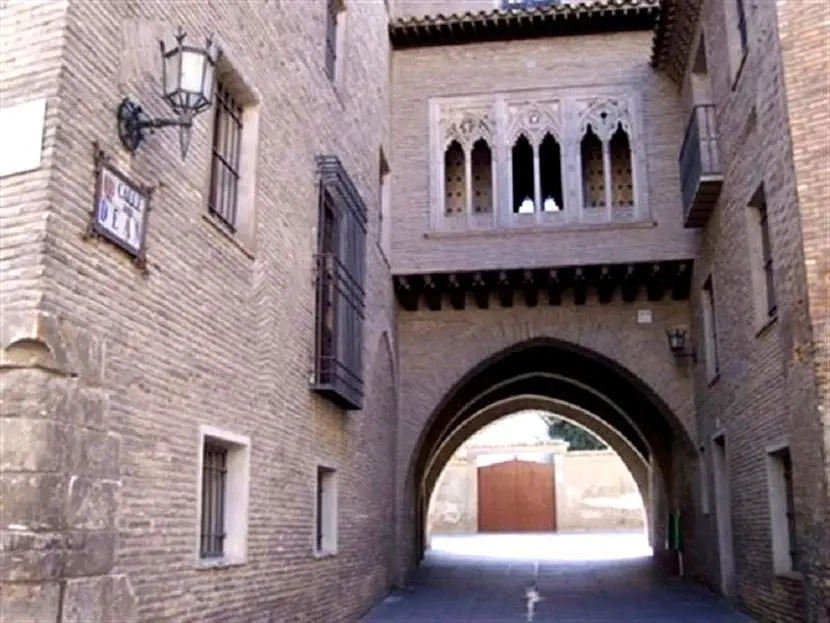
FORUM AND PORT
We have already witnessed in this audioguide (audioguides) that Zaragoza is a city with over 2000 years of history. On the same plot of land where the Iberian Salduie settled, Emperor Augustus founded an important colony named Caesaraugusta, the only colony in the entire Roman Empire which took the complete name of its founder. Important remains are preserved in Zaragoza from this period, among which are the forum, the port, the thermae and the theatre.
In front of La Seo, we can access the Forum of Caesaraugusta Museum, which houses the remains found during excavations carried out due to the remodelling of La Seo Square. These findings mainly belong to two periods: the reign of Augustus and the government of his successor Tiberius. From the Augustus period, remains are preserved of a market which suffered continuous floods provoked by River Ebro. Thirty years after its construction, it was demolished and following the elevation of the floor level between four and seven meters of this area near the river, the Forum of Tiberius was erected in this space.
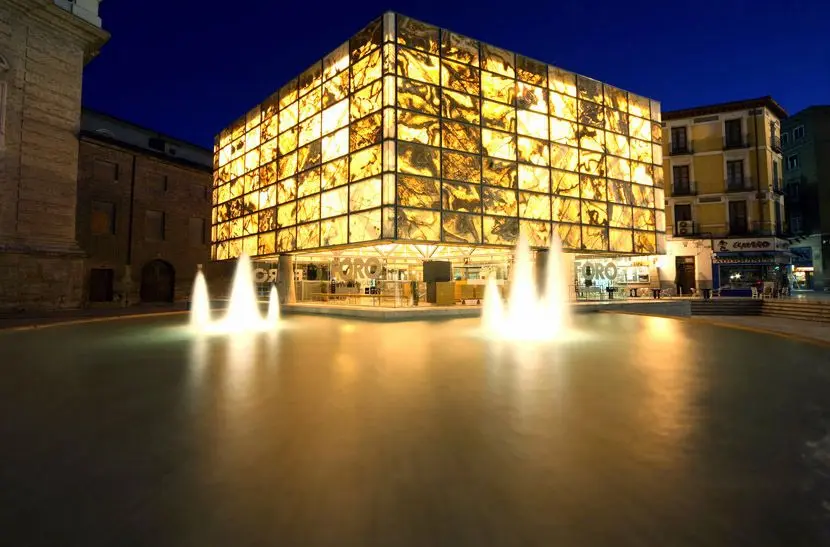
The Forum of Caesaraugusta was a large rectangular square surrounded by arcades where the main religious, political and commercial buildings were located: the basilica, the curia, the tabernae and the main temple. The remains of the forum, which can be visited with the audioguide (audioguides) on the top part of the museum, belong to the foundation of the square's double passageway, as well as the walls which delimited the basements from the shops. This enclosure was the heart of the Roman city: here, citizens gathered in order to listen to politicians, teachers instructed pupils, merchants displayed their goods, councillors dealt with municipal matters in the curia and offerings were made to the gods in their altars. This area's Roman Age character is still present, as the Cathedral Square continues to be a religious, political, economical and social centre in Zaragoza.
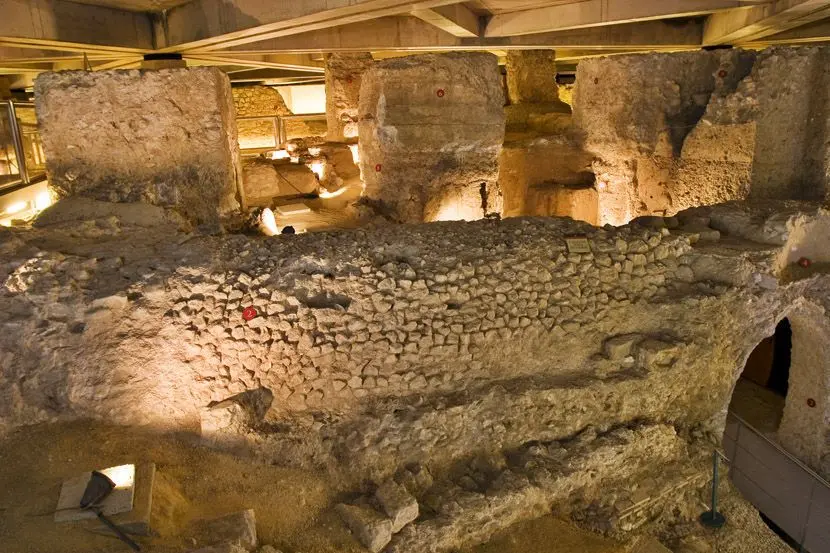
In the lower area of this museum context, next to the remains of the Augustus market, we can see a stretch of sewers which covered the Roman city's underground. In several cabinets, we see elements which show us different everyday life aspects of the Empire's citizens. Fragments of lead pipes, which brought water from River Gallego to the centre of the city, are also exhibited.
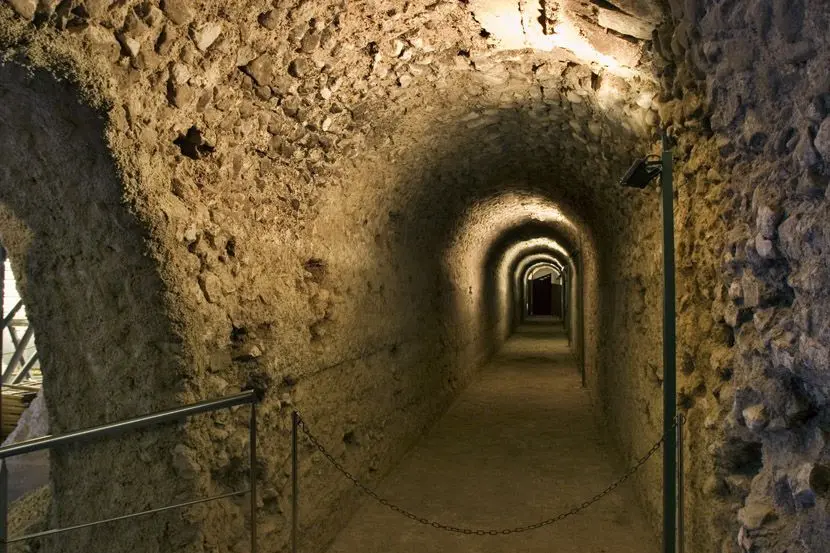
Now, we can head to Saint Bruno Square with the audioguide (audioguides), where we find the Fluvial Port Museum, a good representation of River Ebro's significance in Zaragoza's history since its origins. In the Roman age, the river was navigable from the city of Dertosa (currently Tortosa) to Vareia (Logroño). Thanks to its fluvial traffic, Caesaraugusta became an important port and commercial centre. The boats that navigated through the river from the Mediterranean, brought tiles, marble, jewels, fabric, wine and salt, as well as fashion, customs and cultural novelties from the Roman world. Boats loaded with wool, wood, salt, iron, and leather and furs departed the colony. Caesaraugusta was a main point in this communication route and the fluvial port provided a strong cosmopolitan character to the city.
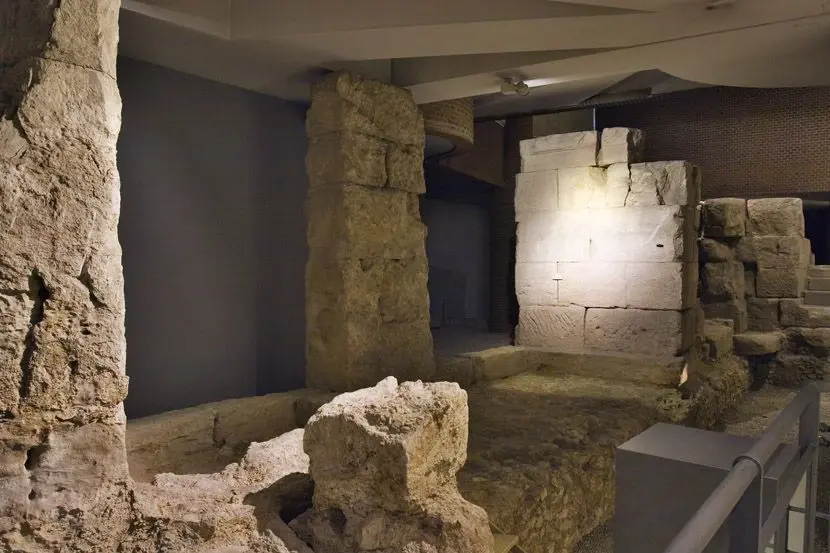
The foundations belonging to a large warehouse where goods where deposited are preserved in the port area. In some ashlars of this building, we can see marks made by the builders, soldiers of legions IV, VI and X, founders of Caesaraugusta.
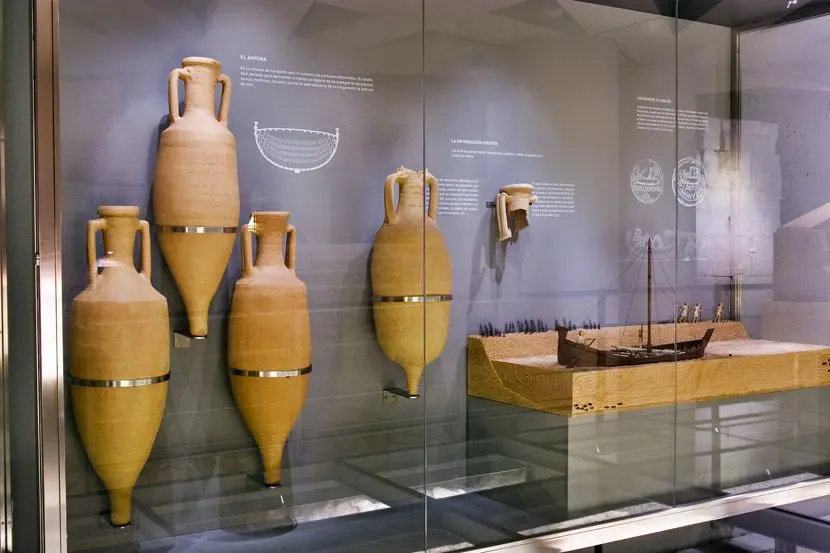
CAESARAUGUSTA´S THEATRE
In San Pedro de Nolasco Square, we can visit the Theatre of Caesaraugusta Museum, the last archaeological space turned into a museum after more than thirty years of excavations and studies.
As we can see with the audioguide (audioguides), this theatre stands out due to its large dimensions: its capacity of 6,000 spectators turned it into one of the largest in Roman Spain together with the theatre in Cadiz. In addition to the two usual side entrances, the Theatre of Caesaraugusta has a third entrance, the only example in the whole of Hispania. It also featured the most modern technical advances such as the velum, a mobile canopy which protected spectators from the sun and rain, and was usually spread out by the sailors who docked their boats in the city's port.
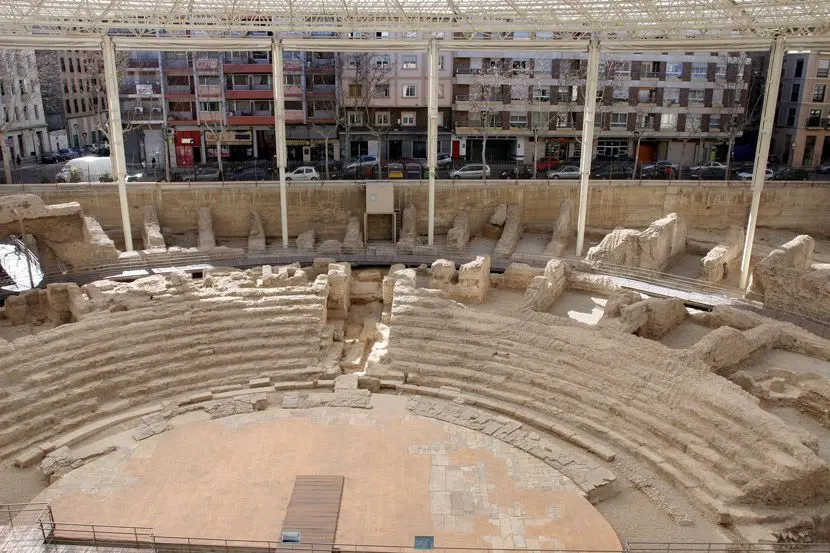
In the museum area, we can find with the audioguide (audioguides) a series of scale models, recreations and listenings which show how these spectacle buildings were physically, as well as experiencing the life and environment during theatre performances. In a small room, which we come across by entering the museum, a set of panels cover the evolution of this plot of land from the Roman age until now, offering us a complete vision of the main stages in the city's history.
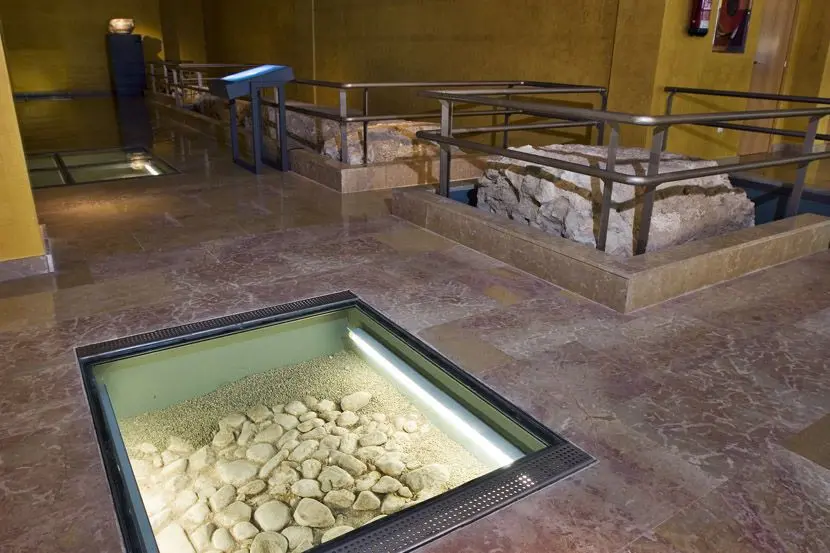
THE CRYSTAL ROSARY
Next to the old Roman theatre, in San Pedro Nolasco Square, is the Church of the Sacred Heart of Jesus, nowadays the Museum of the Crystal Rosary. In this space, lights and glass carriages, which on the 13th of October will travel the city streets in procession, are displayed.
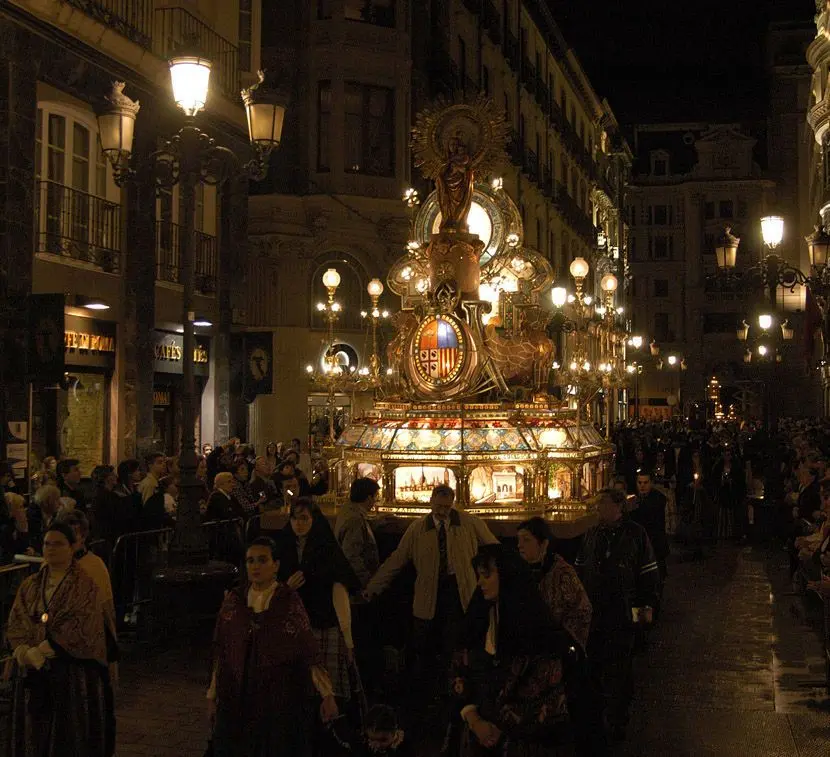
THERMAE
In San Juan and San Pedro Street, which also leads out this square, are the remains of Caesaraugusta's public thermae. This place described in the audioguide (audioguides) was more than a place simply destined to hygiene: it carried out an important social, cultural and sport function. For a reasonable entrance fee (and sometimes for free), citizens gathered for a walk, exercised, took a bath, read, listened to music, poetry or chatted with friends. It featured saunas, hot water rooms, cold water rooms, changing rooms, gymnasiums, gardens and a library. The thermae are good examples of the comfort level which Rome took to its colonies. Both men and women attended, always separated by a different timetable or in different rooms.
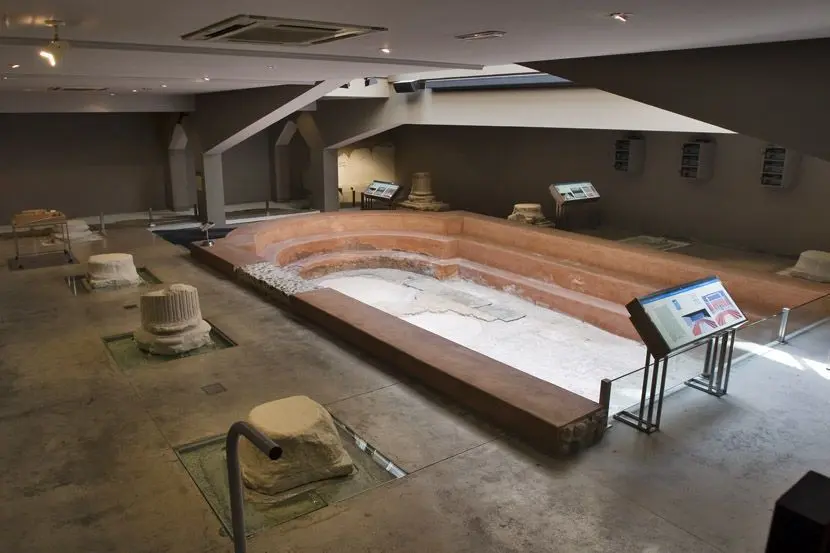
The Museum of Thermae preserves the remains of a swimming pool surrounded by arcades, decorated luxuriously with rich marbles and sculptures. In the cabinets, we can see reproductions of some of the accessories Romans used in the thermae: wooden clogs to avoid burning their feet in hot rooms, towels, sponges, hygiene sticks for ears or strigilis for rubbing skin. We can also see the recreation of latrines, which had a capacity for 29 people in the I century BC.
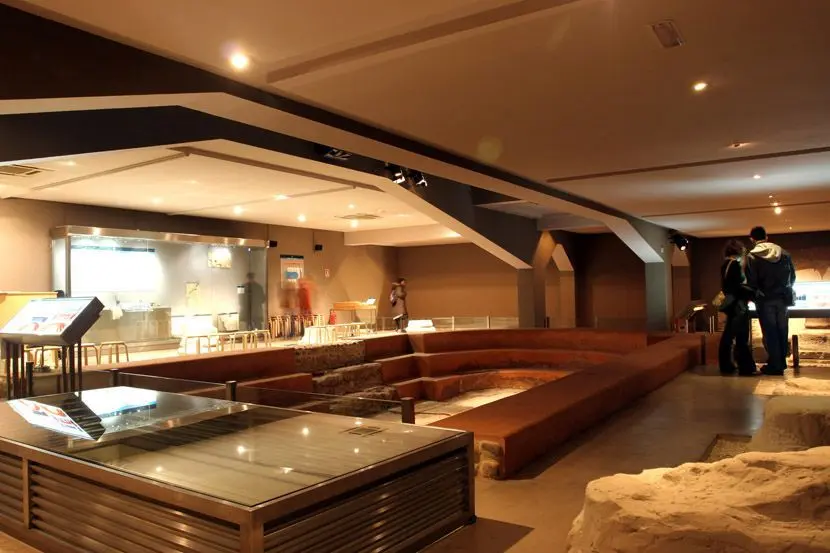
THE MAGDALENE
Near these two Roman museums, at the end of Mayor Street, we can enjoy with the audioguide (audioguides) one of the best examples of Mudejar style in the city: the Church of Magdalene. Its magnificent brick tower decorated with glazed tiles, and very similar to the Towers of Saint Martin and El Salvador in Teruel, stands out in the exterior.
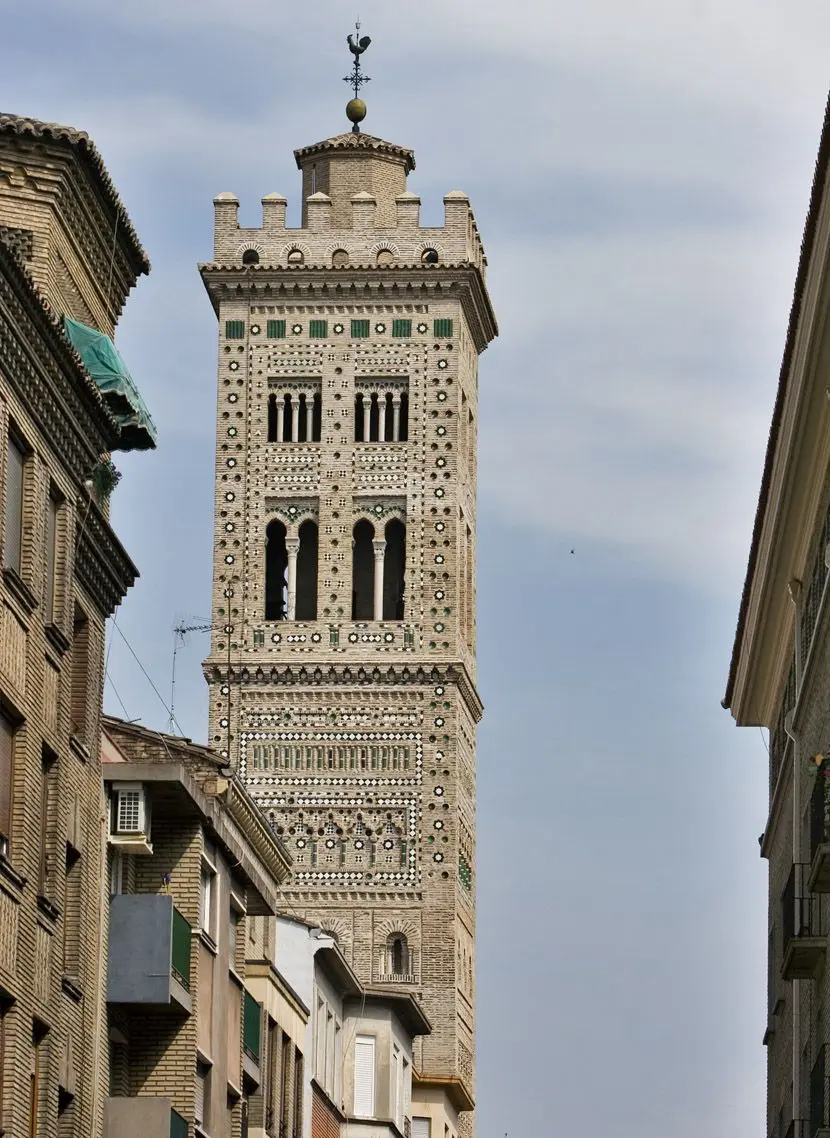
GOYA: MUSEUM OF CAMÓN AZNAR (PAINTING AND ENGRAVING ROOMS) AND MUSEUM OF ZARAGOZA (GOYA ROOMS)
The intimate relationship between Goya and Zaragoza, both on a human and artistic level is undisputable and was alive, even in the distance, throughout his entire life, as related in this audioguide (audioguides).
In addition to the frescos of the Basilica of Pilar, works by Goya are displayed at the Ibercaja Museum of Camón Aznar and the Museum of Zaragoza.
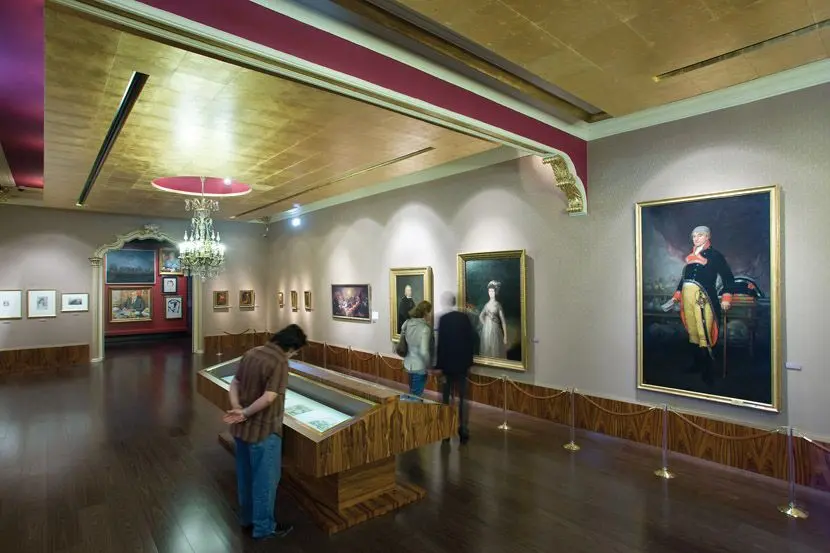
The Ibercaja Museum of Camón Aznar is the only museum in the world which permanently shows the entire series of engravings performed by Goya. In the first, he initiates his etching technique, copying works by Velázquez, which he considers one of his masters. Caprichos reveal a critical vision of Spanish society in his time, anchored in ignorance and superstition. The Disasters of War make him the first graphic reporter in history, where he reflects pain, cruelty and the terrible consequences of war. In Tauromaquia, he offers vivid prints of bullfighting spectacles in his period. The Foolishness seems to serve as an escape for all his fears and anxiety. In his last engravings, an old aged Goya experiments with the new technique of lithography in the Bulls of Bordeaux.
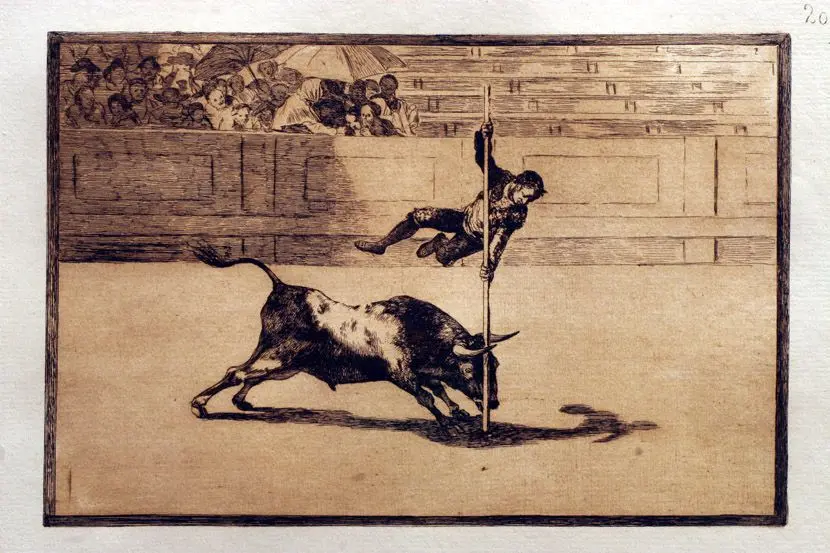
This museum that we can visit with the audioguide (audioguides) also features a room of paintings, the Golden Room, which displays works by Goya belonging to IberCaja and the Real Sociedad Económica Aragonesa de Amigos del País - The Royal Economic Aragon Society of Friends of the Country. Among these works, the magnificent portraits of Don Félix de Azara, Queen María Luisa of Parma, and a youth Self-portrait of the artist or the outline of the Coreto's vault stand out.
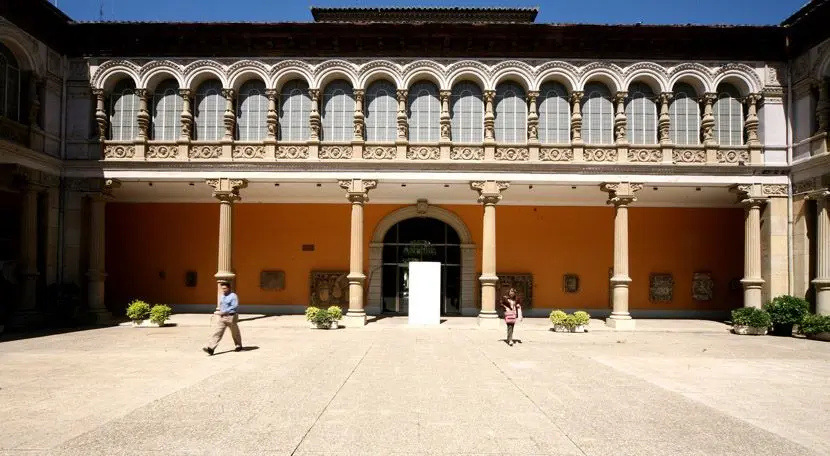
In the Museum of Zaragoza, we find a collection representing all the painters' stages, allowing us to follow his evolution from works performed in his youth until reaching full maturity. In this interesting exhibition, special attention is given to Goya's artistic training stage, both in Zaragoza and in Italy. In addition, large portraits can be seen of significant personalities of the royal family and Spanish politics, such as Ferdinand VII of Spain, the Duke of San Carlos or the infante Luis María de Borbón as well as friends of the artist such as Goicoechea and his own relatives, his son Javier and the latter’s wife Gumersinda. After visiting this museum with the audioguide (audioguides), we get to understand the evolution of an artist in a better way, who although trained within the artistic norms of the period he lived in, he was able to create his own language and an unrepeatable unique style.
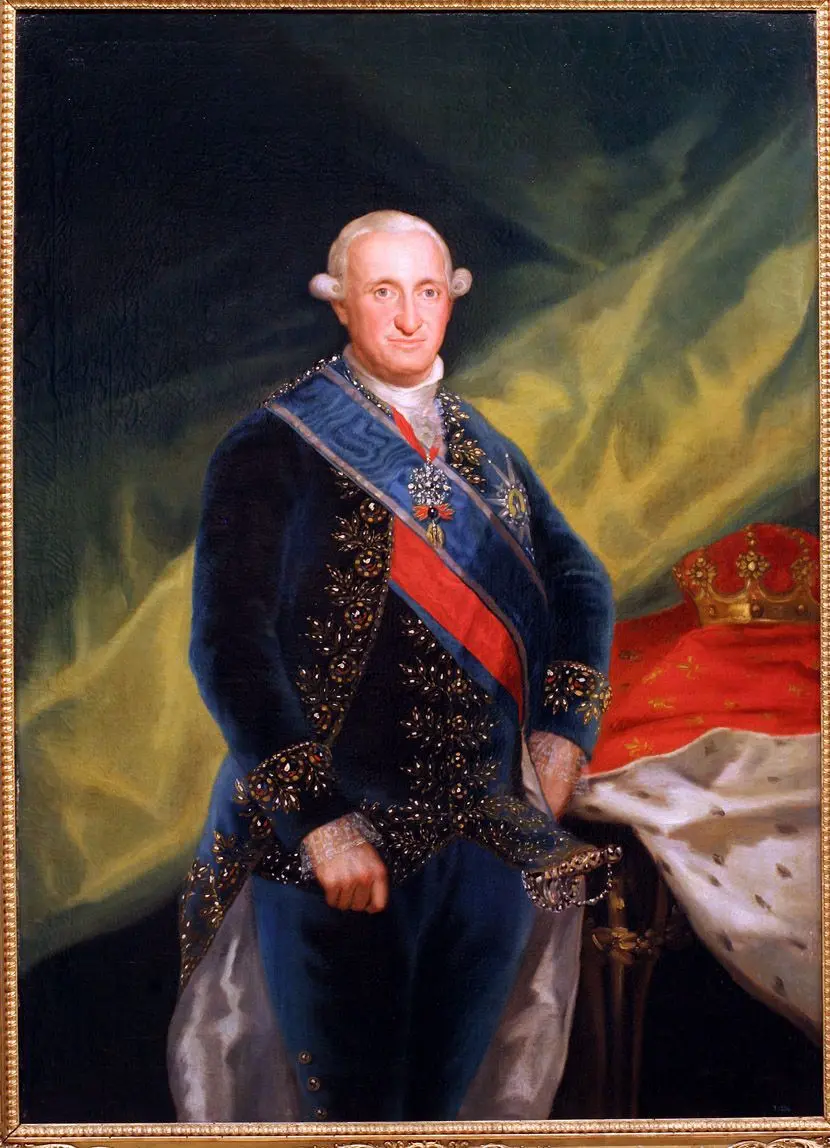
MUSEUM OF PABLO GARGALLO
The Museum of Pablo Gargallo has its origins in the agreement signed in 1982 by the daughter's sculptor, Pierrette Gargallo, and the Mayor of Zaragoza, Ramón Sainz de Varanda. The artist's heirs agreed to donate a series of sculptures, drawings, cartons and documentation. The Town Hall agreed to restore the Argillo Palace, transforming it into the museum's headquarters, which was inaugurated in 1985. Recently, it has been extended by means of joining the adjacent building, and its installations have been updated. I recommend that you visit it with time and with the audioguide (audioguides) in order to discover and enjoy this great artist.
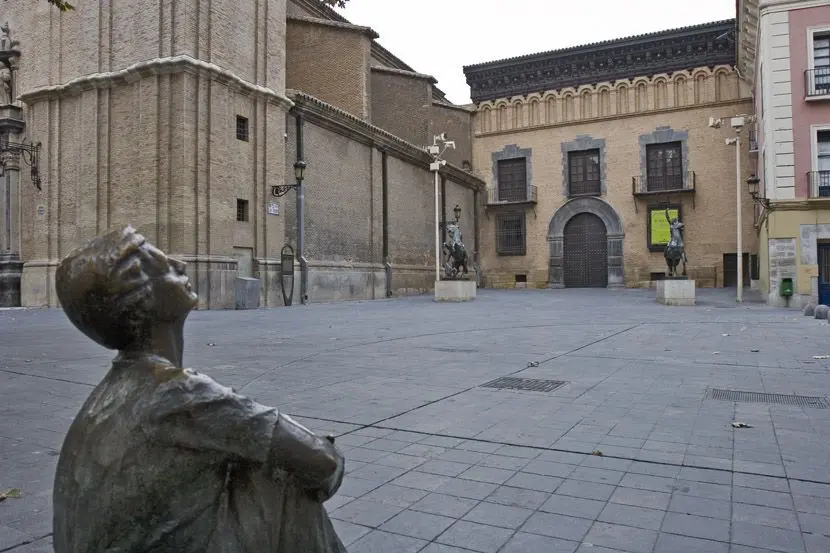
The building which hosts the museum was built in the mid XVII century, as an extension of the houses belonging to don Francisco Sanz de Cortés, later Marquis of Villaverde, Count of Morata and Atarés. As we can see in its façade, it follows the model of Zaragoza’s Renaissance palaces, although blended with Baroque elements. In the interior, the patio with columns features reliefs of the twelve zodiac signs which alternate decorations of masks and fruit.
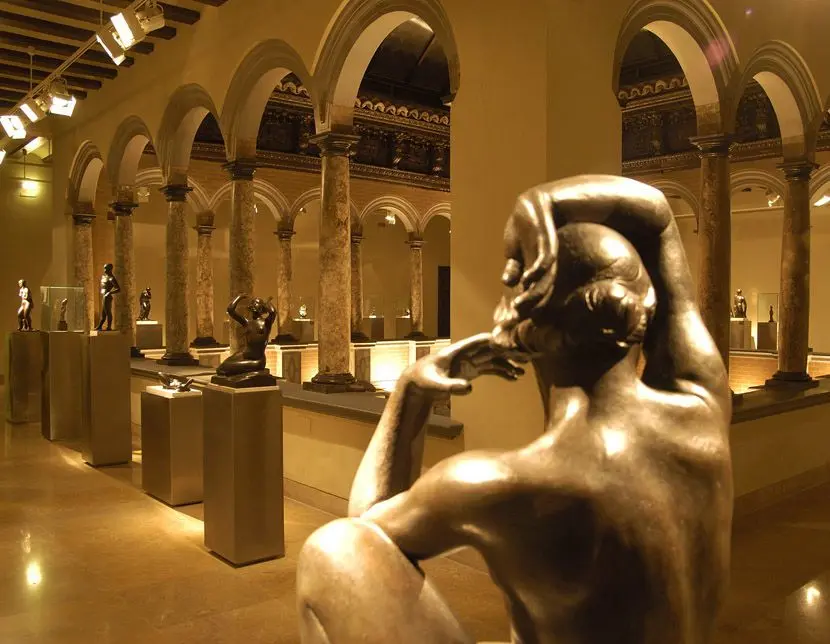
Pablo Gargallo was born in Maella, Zaragoza, in 1881. When he was seven years old his family moved to Barcelona in search of a better life. All his human and artistic training took place at the ciudad condal - the count city Barcelona, where he started as an apprentice of Eusebi Arnau and was pupil of the academy Escuela de la Lonja. In his youth, he was a regular at the café Els Quatre Gats, where he met with other artists such as Pablo Picasso, Isidro Nonell or Manolo Hugué. In his first trip to Paris in 1903, he discovered the works of Rodin, which would produce a deep impact on him. Back in Barcelona, he presented his first individual exhibition and performed the sculpture decoration of Hospital de la Santa Cruz and San Pablo, and the Palace of Catalan Music, both buildings designed by the architect Doménech i Muntaner. In 1912, he settles in Paris and from then onwards lives in both cities, working tirelessly in spite of his fragile health. After displaying his work with great success in New York and Barcelona, he passes away in Reus, Tarragona, in 1934 with 53 years of age and just when he was beginning to be internationally renowned.
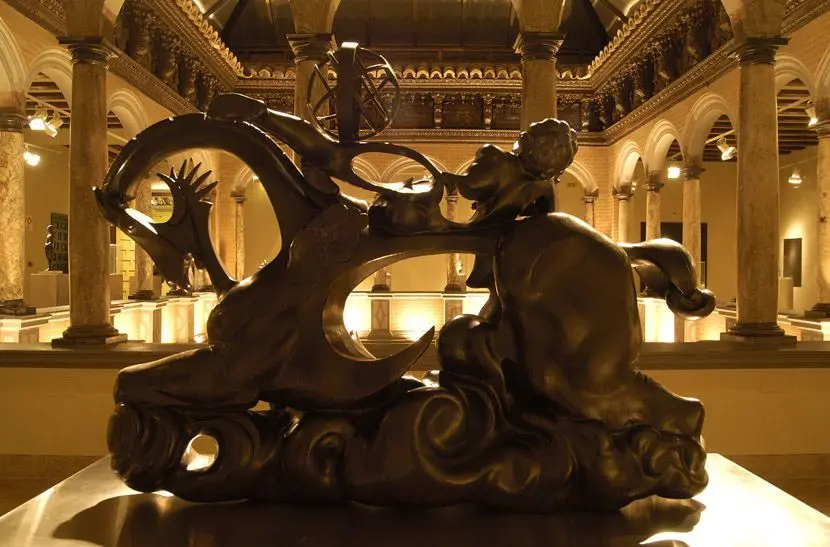
Gargallo has been one of the greatest creators of sculpture in the XX century. Throughout his entire life, he was able to create classical works together with sculptures which explored the limits imposed by tradition. In this search of personal and innovative language, he researched the use of new materials such as copper, iron and lead sheets. In formal work, he introduced emptiness as a decisive element in sculpture construction and he opened new expressive paths which many artists followed later on.
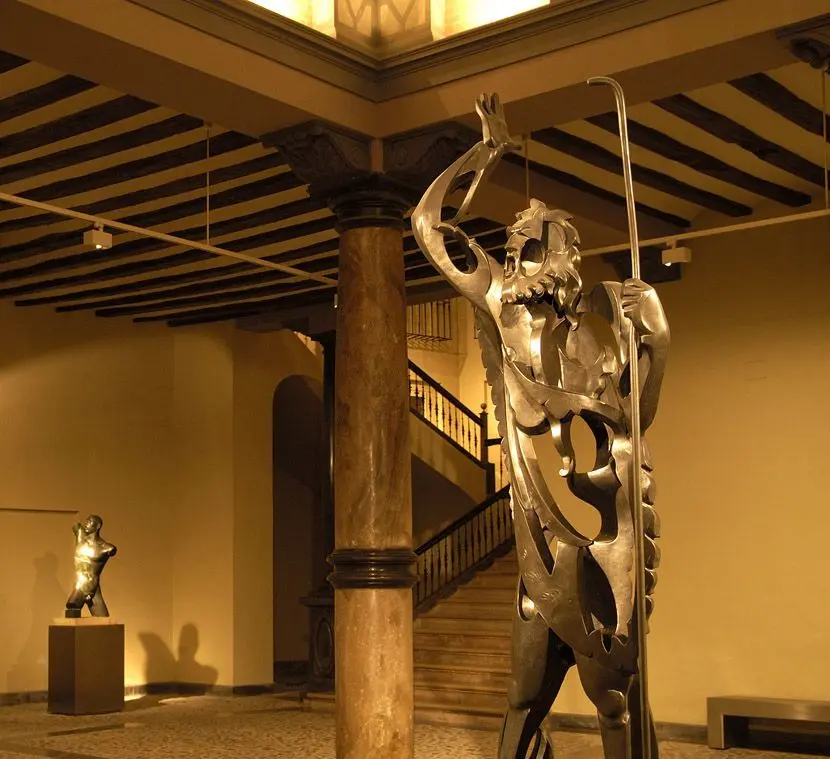
In this museum we are visiting with the audioguide (audioguides), we can enjoy works representing all his creative stages, highlighting The Great Prophet, which can be found presiding the central patio, his masks, Uranus, Kiki de Montparnasse or Hommage à Chagall.
LEISURE, COMMERCE AND GASTRONOMY IN ZARAGOZA
Zaragoza has always been one of the cities with the greatest commercial richness in Spain due to its strategic enclave which has made it a meeting point for goods, tendencies and fashion. Strolling along its streets with the audioguide (audioguides) is enough to discover the immense existing options and the coexistence between specialized shops and the more modern commercial centres. The products offered are varied and satisfy the needs and tastes of all.
There are many commercial areas, some specializing in fashion, such as the Independence Avenue, the Centre, the neighbourhood of the Delicias or the Square of the Sieges, and others specializing in typical products, alternative fashion or specialized shops such as the old quarter.
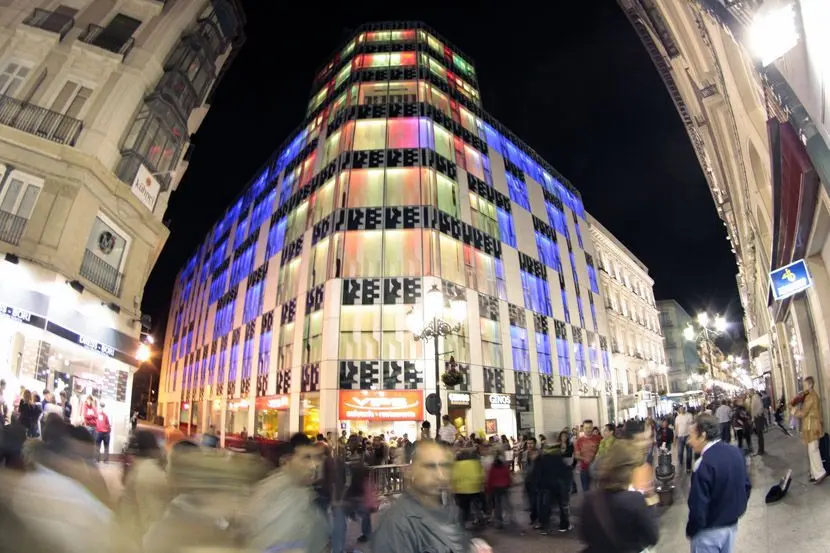
There is a wide offer of commercial centres, and among these we can find all types of shops as well as a great variety of leisure and entertainment options such as cinemas, video arcades, bowling alleys, etc. Some of the busiest centres are Augusta, Grancasa, Aragonia, Plaza Imperial or Puerto Venecia.
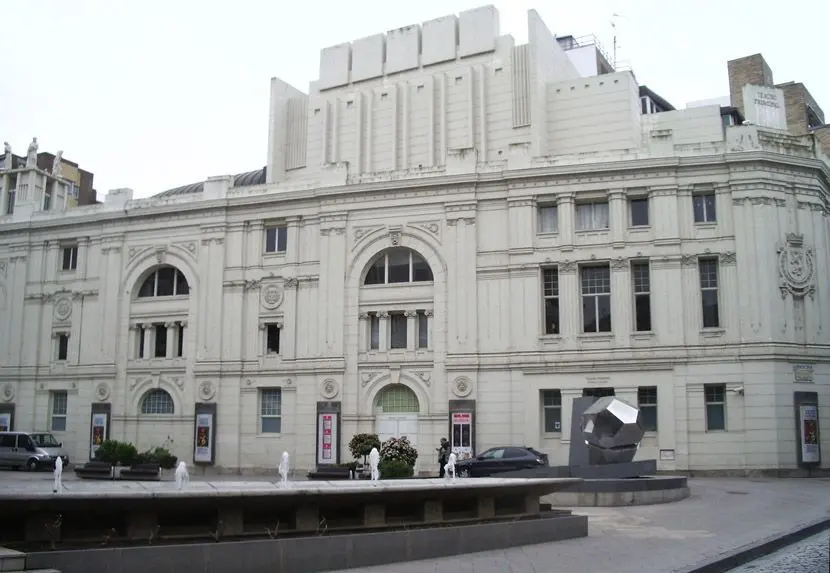
Zaragoza is a city which is warm and friendly and lives in the street. In addition, it has a significant number of cinemas, theatres, entertainment halls and green spaces which offer a wide range of options in order to enjoy free time. Good examples of these recreational options are the Teatro Principal, the Teatro del Mercado, the two auditoriums, several concert halls or El Plata Cabaret Ibérico.
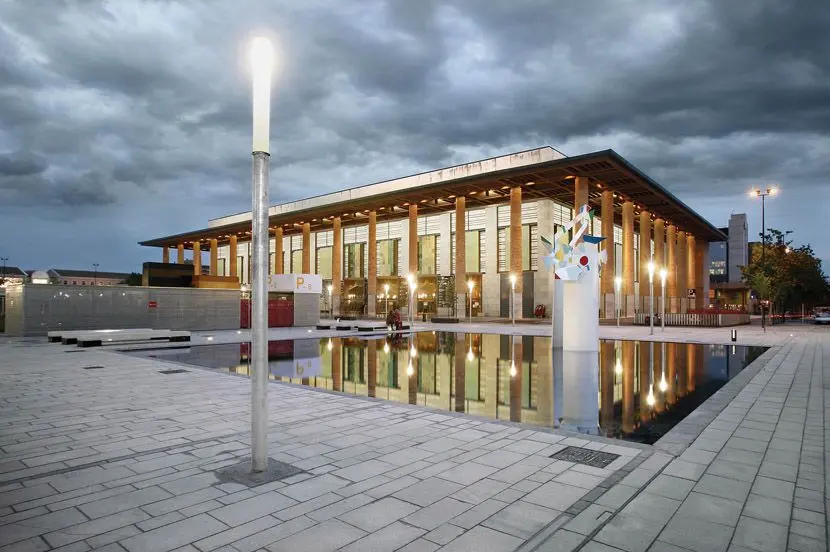
Highlight of this audioguide (audioguides), Zaragoza's gastronomy is simple, strong and full of character, based overall on autochthonous products. Aragon land supplies delicious vegetables, which are the basis of a healthy, tasty, authentic and nutritious cuisine. Lamb, pork, beef or poultry are used for cooking strong stews, ideal for the winter season. Fish is also available, even though it is an inland province. As far as desserts are concerned, we can enjoy delicious fruit from Ebro's valley and a great variety of sweets and confectionery, such as almond turron or Moorish crespillos - leaves dipped in sweet batter and fried - and candied Fruit of Aragon covered with chocolate.
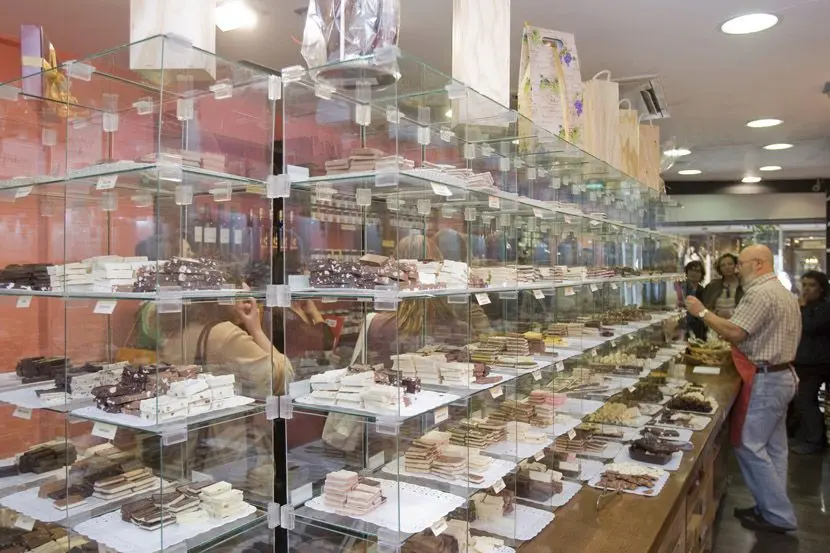
Without forgetting the four wine Designations of Origin in Aragon: Calatayud, Campo de Borja, Cariñena and Somontano, which produce better and better wines adapted to current tastes.
Going for tapas is one of the local people's passions, which is easily passed on to visitors. There are many places in the city, but the most popular and traditional, the area par excellence, is Tubo, the heart of the old quarter.
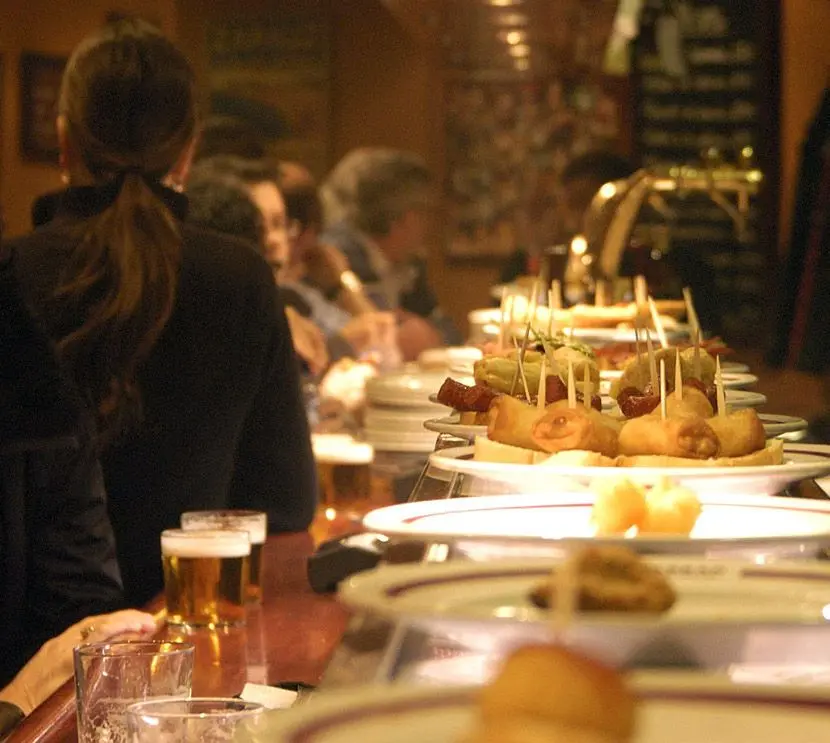
Down its narrow streets, old lifetime bars mix with colourful and modern ones. Santa Marta Square is already a classic area for tapa lovers in our city. Located behind La Seo, it is a small pedestrian square which becomes a large open-air terrace when the weather is favourable.
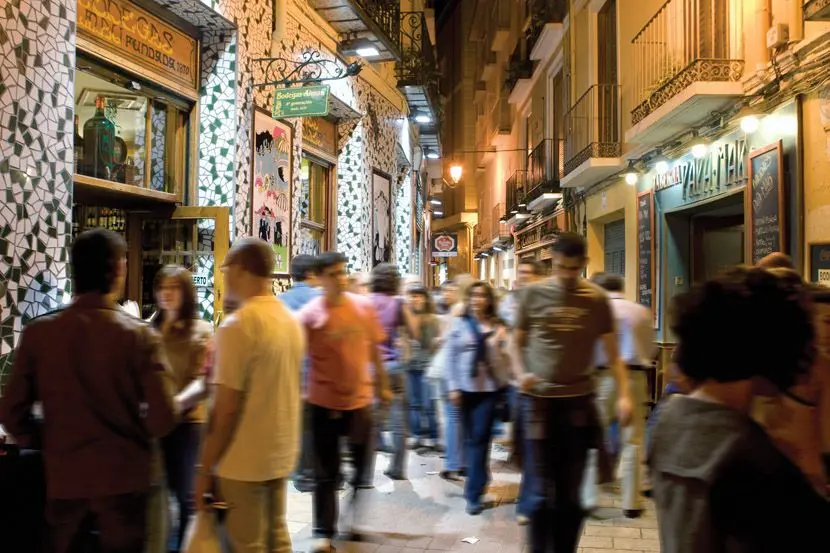
The ideal place to discover the basic ingredients of Zaragoza's gastronomy is the Central Market, which is located in Lanuza Square, the city's main market place since 1210. The architect Félix Navarro designed this eclectic functional building, where iron and glass combine creating a wide, light and open space. Following the stalls last restoration and renovation, it still preserves its hustle and bustle and everyday activity.
From Zaragoza Turismo we hope that this audioguide (audioguides) service has been of your liking and we want to appreciate the confidence you have placed in our firm. We hope it has been useful in learning more about the city and we invite you to visit any of our tourism offices, where more information can be supplied as well as other tourism services to continue enjoying Zaragoza.
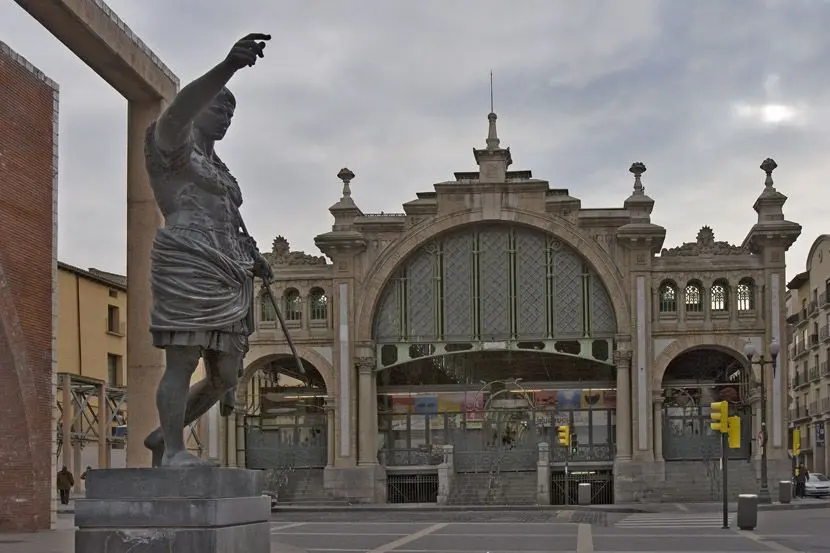
Bluehertz Audio guides has developed for Zaragoza´s town hall an audio guide service and videos available in Spanish, English, French, German, Italian and Portuguese languages.
Zaragoza Tourist Office address: Plaza de Ntra. Señora del Pilar s/n 50003 - Zaragoza.
- Tel: +34 902 14 2008
www.zaragoza.es/turismo
Audio guide devices, Multimedia audio guides,
Audio guide GPS tourist bus-train, charging bases and accessories.
Group guidance systems, headsets, charging cases, tour guide systems accessories.
Audioguides available from mobile devices, web App, downloadable App from Google Store.
Audioguides in several languages, translations, voiceovers. Audio descriptions, signoguides, visual contents for audioguides. 3D Reality.